The Date of
Jesus' Birth
How
December 25th Became Jesus' Birthday
William S. Abruzzi
(2018)
.jpg)
Although December 25th
is the date on which most Christians celebrate Jesus' birth, no one
knows either the day or the year in which Jesus was born. The December 25th
date was established during the late 4th century, nearly 400 years
after Jesus died, and continues to be rejected by some 200-300 million Eastern
Orthodox Christians who celebrate the event on January 6th. Establishing the date of Jesus' birth was a work in progress for nearly four
centuries, during which various dates were proposed. It appears most likely that
the December 25th date resulted from the borrowing of a then-popular
pagan mid-winter celebration.
Early
Christians did not celebrate Jesus' birth. The
birth of Jesus did not acquire the same importance in early Christianity as did
Easter (Brown 1977: 28), which was celebrated shortly after Jesus' death.1 There
is no mention of its celebration in
Acts.
There is also no mention of
birth celebrations in the writings of early Christian writers such as Irenaeus
(c. 130-200) or Tertullian (c. 160-225).
Near the end
of the second century, Clement of Alexandria (150-215) (Stromata I,
21,145.5) ridiculed those who tried to establish the birth date of Jesus.
Indeed, birth celebrations were rejected as unchristian.
As late as the third century, Origen
of Alexandria (184-253) (Commentary on Matthew XIV,
6) objected to the
celebration of any birthday as being a pagan custom, pointing out that in the
Bible only the "heathen and the godless" (such as Pharaoh and Herod) celebrated
their birthdays.
Origen goes so far as to mock Roman
celebrations of birth anniversaries, a strong indication that Jesus' birth was
not marked with similar festivities at that time.
Jesus' birth also had no
theological significance. For Christians, it was Jesus' death and resurrection
that mattered, not his birth. Every Lord's Day
(later called Sunday) was celebrated as a "day of resurrection." From the very
beginning of Christianity the feast of Easter and the holy days associated with
it --which specifically celebrated Jesus' death and resurrection-- constituted
the foundation of Christian worship. Likewise, all festivals honoring his
apostles and later Christian martyrs were associated with their deaths, not their births. As Cullmann (1956: 21) notes,
Our Christmas festival of December
25th was unknown to the Christians of the first three centuries. Down to the
beginning of the fourth century this day, subsequently to become a central date
in the Christian Church, was allowed by the Christians to pass by unhonoured and
unsung, without any assembling together for worship, and without Christ's birth
being so much as mentioned.
And,
of course, there is no mention of snow or cold temperatures in either Matthew's
or Luke's infancy narrative, which effectively rules out a December birth.2 As
Jenkins (2011: 47) points out, "No sane Judean shepherd would have been out on
the hills watching his flocks in December." Having shepherds
"tending their flocks in the field"
in December (Luke 2: 8) demonstrates an ignorance of Palestinian climate and
sheepherding ecology in which animals are more likely to be corralled and
protected in the winter and pastured primarily during the warmer months when the
fields are covered with grass.
|
 |
 |
Bethlehem
(December 2015)

Jerusalem
(January 2013)
Christmas did not become a significant Christian holiday until the 4th
century CE. One indication of the late
date for the origin of Christmas is the fact that it recurs on a fixed calendar
date every year. This is a result of its being based on the later Roman
solar calendar rather than on the earlier Jewish
lunar
calendar, as is Easter, the celebration of which occurs on a different calendar date each
year. In addition, according to Kraabel (1982: 275), Jesus is not presented as
an infant in the earliest Christian art and literature, but rather is portrayed
sometimes as a youthful figure similar to Dionysius and Apollo, but more often
as an older, ageless figure. The earliest painting of the Virgin and Child, with
Balaam holding a scroll and pointing to a star (see Numbers 24: 17), is dated to
at least the third century and possibly later.
". . . a
star shall come forth out of Jacob, and a scepter shall rise out of Israel "
(Numbers 24: 17)
.jpg)
Virgin and Child
(Catacombs of St. Priscilla, Rome)
It
was only a matter of time, however, that Jesus' birth (Incarnation)
would take on soteriological importance.
Once faith in the
crucified and exalted Lord had been taken as the starting-point of theological
reflection on the question of Christ's person and work, his incarnation was
bound to become more and more central in devout speculation. (Cullmann
1956: 24)
Given
initial ecclesiastical indifference with respect to Jesus' birth date, numerous
proposed dates circulated during the earliest Christian centuries (see Cullmann
1942; Strittmatter 1956; Kraabel 1982). At the beginning of the third century,
Clement of Alexandria noted that Christian groups had
proposed several different days as the date of Jesus' birth. According to
Clement,
There are those who have determined not only the year of our Lord's birth, but
also the day; and they say that it took place in the 28th year of Augustus, and
in the 25th day of [the Egyptian month] Pachon
[May 20 in
our calendar]. . . . Further, others say that He was born on the 24th or 25th
of Pharmuthi [April 20 or 21]. (Clement, Stromateis 1.21.145;
quoted in McGowan 2012; see also Winter 1955:235)
Significantly, while
Clement discussed several proposed dates, he did not mention December 25th
as one of the dates claimed at the time. Clement himself
(Stromata 1:21) thought that Jesus was
born on November 18th and wrote,
From the birth of Christ,
therefore, to the death of Commodus are, in all, a hundred and ninety-four
years, one month, thirteen days.
[This calculates to be November 18th.]3
Several spring dates were proposed as the birth dates of Jesus, including April
2nd, April 19th, March 25th, March 28th and May 20th (see Cullmann 1956: 21-23;
Kraabel 1982: 274-275). The preference for a spring date was based on the belief
that the world was created in the spring. According to Genesis (1: 4-5),
it was on the first day of creation that
"God
separated the light from the darkness. God called the light Day, and the
darkness he called Night." The belief
was that on the first day of creation
light and darkness were divided into two equal parts. The first day of creation
must, therefore, have occurred on the
vernal equinox,
the date when night and day are of equal length. While the vernal equinox falls
on March 21st in our modern calendar, it occurred on March 25th in the Roman
calendar. Because Jesus represented the "new
creation," it was believed that his birth would have coincided with the date of
the original creation. This would have been consistent with the gospels claim
that Jesus was crucified in the spring. Since Jesus, as a perfect divine
being, would have lived complete (not partial) years, it follows that his
crucifixion would have occurred on March 25th.4
Based
on a slight modification of the above
argument, De Pascha Computus,
dated 243 CE (see Cullman 1956: 22; Talley 2000: 269), calculated that Jesus'
birth occurred on March 28th. Many early Christians associated Jesus with the
sun (see below), following Malachi's (4: 2) reference to the messiah as the
"sun of righteousness."
Genesis (1: 14-19) states that the sun was created on the fourth day of
creation. Following the belief that the first day of creation was March 25th,
the sun --and by extension Jesus' birth-- would have occurred on March 28th.
But for you who fear my
name the sun of righteousness shall rise, (Malachi 4:2)
A
similar theological arithmetic was used to
argue for
a December 25th birth date. During the third century, Julius Africanus claimed
that December 25th would have been Jesus' birth date, based on his belief that
Jesus would have been conceived
(the real beginning of his life) on March 25th and would have gestated a perfect
9 months in the womb. Africanus similarly assumed that Jesus
would have lived in perfect whole years and would, therefore, have been
crucified on March 25th. In
about 400 CE, Augustine of Hippo mentions a local dissident Christian group,
the Donatists,5
who kept Christmas festivals on December 25, but refused to celebrate the
Epiphany on January 6,
regarding it as an innovation (McGowan 2012).6
The use of the March 25th death date to justify the December 25th birth date clearly
illustrates the popularity of the former with regard to dating Jesus' birth.
Basing the latter date on the former date would have given it greater legitimacy
and, thus,
would have facilitated the Roman Church's attempt to establish the
orthodoxy of the December 25th date.
Egyptian Gnostic followers of Basilides in the 2nd century celebrated Jesus'
birthday on January 6th.
According to Ray (2000: 116-129), celebrations of the nativity in Palestine
initially took place in the middle of May. These celebrations were later moved
to January, and then finally to December during the 4th century. The Feast of the Nativity
continues to be celebrated on January 6th by the Armenian Orthodox
Church. A tradition is also found in Epiphanius (Panarion [c. 374-377] LI, MPG tome XLI, col. 928 ff.),
bishop of Salamis in Cyprus, according to which Jesus was born in the 42nd year of Augustus' reign (29 years
after the Jews had become subject to the Romans) on the 13th
Tebeth in Jewish,
the 11th Tybi in Egyptian, or the 8th
Audyneos in Syrian cylindrical
reckoning, which corresponds to the night linking the 5th and 6th of January in
the Julian calendar (743 years ab urbe condita)7
(Winter 1955:234).
According to Roll (2000: 274-275), the earliest "hard evidence" that December 25th
was celebrated as Jesus' birthday comes from the
Chronograph or almanac of
Furius Dionysius Philocalus (354 CE). This almanac contains three lists of
dates, which "taken together serve to indicate that by the year 336 the
nativity of Jesus stood at the start of the new year." (see also McGowan 2012).
However:
One list, the Fasti consulares,
a chronological listing of the consuls of Rome, includes the statement,
"Christ is born during the consulate of
C. Caesar Augustus and L. Aemilianus Paulus
on 25 December, a Friday, the 15th day of the new moon."
According to Roll
(2000: 275), this statement was awkwardly inserted into a secular list of Roman
consuls containing several factual errors, raising questions regarding its
authenticity.
A
second list, Depositio episcoporum, contains the names of Roman bishops who lived from 255 to
352 CE. The entries are arranged in order of their death dates
beginning on December 26. The first date
listed, December 25, is marked: natus Christus
in Betleem Judeae: "Christ was born in
Bethlehem of Judea" (McGowan 2012). However, the last two entries --Marcus, who died in
336 and Julius who died in 352-- are out of order, suggesting a later insertion
(Roll 2000: 275).
Since Sylvester, the most recent of the popes listed in correct order, died in December
335, Roll believes the source material can be reliably dated to the year 336. He
thus concludes, "the fact that it is arranged as if December 25 is the beginning
of the year . . . suggests that the nativity feast
had by then acquired its position as the start of the Christian year" (ibid.)
Significantly, a civil calendar included as part of the same Chronograph
notes December 25 as N(atalis) Invicti, a Roman civil holiday
honoring the birth of the invincible sun (ibid.),
with no mention of the nativity of Jesus (ibid.).
Equally problematic, according to Roll, is a
note contained in the third document Depositio martyrum, which begins:
"Christ is born on
the eighth of the calendar of January, in Bethlehem of Judea"
(ibid.).
The problem here is that the source in which this date is found is a list of
martyrs who died in Rome and who were buried in or near the city. The belief at
that time was that a Martyr's death date was their birthday into heaven, and that
this was the day that should be celebrated. However, Jesus' death date is not
indicated, making the inclusion of Jesus' birth date (as the day he was
physically born) among the list of birthdates (i.e., death dates) of martyrs
highly problematic. Roll (ibid.) suggests that Jesus' birth date may have
been a later insertion into this document.
It
was not until the late 4th century that December 25th
became established as the official date of the nativity in the West, and, even
then, had to be promoted among the general populace by offering a theological
justification. Gregory of Nazianzen
had preached sermons on the feasts of Christmas and the Epiphany in 379-380. In his sermon for the Epiphany, he
claimed to have been the exarchos
(originator) of the Christmas feast, not in 379,
but apparently shortly before (ibid.). John Chrysostom (
349-407),
Archbishop of Constantinople,
preached his sermon In diem natalem, on the date of the Nativity in 386, with the goal of justifying the introduction/imposition of this feast in the
Eastern Church less than ten years before (Roll 2000: 276). Chrysostom used
several arguments to support December 25th as Jesus' birth date.
Citing the words of Gamaliel:
"If it be of men, it will come to naught; but
if it be of God you cannot overthrow it, lest perhaps you be found even to fight
against God" (Acts V, 38-39).
Chrysostom argued that the validity of the December 25th date is confirmed by
its widespread acceptance by the Christian community within a comparatively
short period of time (Strittmatter
1942: 601-602). This
justification is both factually incorrect and illogical. It took over 300 years
for the majority of the Christian community to accept December 25th as the birth
date of Jesus. There was widespread resistance to this date, and it only
succeeded in becoming established as a result of its imposition by the Roman
Church. Also, a whole variety of false beliefs have been rather quickly
accepted by large numbers of people. Gamaliel's quote (assuming it is
authentic) could just as easily be used to validate the beliefs of other
religions, including Muslims, Hindus and Mormons.
In his sermon
In diem
natalem
of 386, Chrysostom supported this
position by appealing to the records of the census of Quirinius mentioned in
Lk 2:1-7
(Kraabel
1982: 278). He claimed that the December 25th feast originated at Rome, where the records of
the census of Quirinius were preserved, though those records were never
produced. Indeed, it is highly unlikely that they even existed or would in any way
have confirmed a December 25th date.
Chrysostom
further argued that, according to Luke (1: 8-13), Zechariah, the father of John
the Baptist, received the message of the archangel Gabriel six months before the
tidings were brought to Mary while performing his priestly rituals in the Holy
of Holies in the temple.
Now
while he was serving as priest before God when his division was on
duty, according to the custom of the priesthood, it fell to him by lot to enter
the temple of the Lord and burn incense. And the whole multitude of the people
were praying outside at the hour of incense. And there appeared to him an angel
of the Lord standing on the right side of the altar of incense. And Zechari′ah
was troubled when he saw him, and fear fell upon him. But the angel said to him,
"Do not be afraid, Zechari′ah, for your prayer is heard, and your wife Elizabeth
will bear you a son, and you shall call his name John."
(Luke 1:
8-13)
Only
on one day of the year, Chrysostom argued, was the high priest permitted to
enter the Holy of Holies; this was on the tenth day of the seventh month.
Calculating that Jesus' conception occurred 6 months later and that his birth
occurred 9 months after that, Chrysostom determined that Jesus was born in the
month of Appelaios (December in the Roman calendar).
There is, however,
no historical foundation for this; at no time was anyone named Zechariah ever a
High Priest, and the altar of incense was not located inside the Holy of Holies
(Winter 1955: 234). Furthermore, Luke's description of the birth of John is so
directly modeled on the birth of Samuel (1Samuel:1-2; see Freed 2001:87-89;
Abruzzi When Was Jesus Born?, note
35) that it cannot be considered an accurate historical account upon which to
determine the date of Jesus' birth.
Constantine and the Celebration of Christmas
Some
have associated the origin of the celebration of Christmas with the conversion
of Constantine to Christianity. Indeed, many have placed significant emphasis on
the personal role of Constantine and his program to recognize Christianity.
Other scholars, however, point to Constantine's decree in 321 limiting labor
on Sunday as evidence of his continuing devotion to
Sol Invictus, the
Roman Sun God, at least as much as to the day of the resurrection of Christ
(Talley 2000: 265).
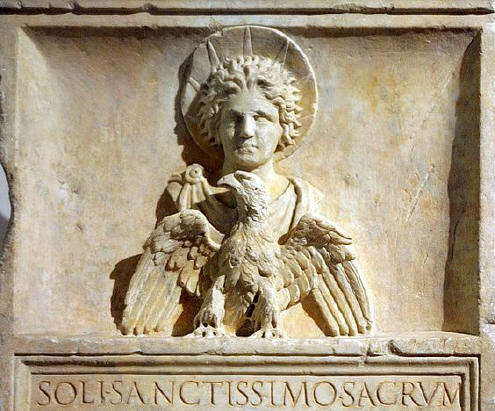
Sol Invictus
While
Constantine was committed to making Constantinople the new Rome, several factors
contradict the argument that he introduced December 25th as the day
to celebrate Jesus' birth. One objection concerns the fact that no recognition
was given to Jesus' nativity on the day of the natalis invicti at
Constantinople throughout Constantine's lifetime (Talley 2000: 267). Indeed,
Roll (2000: 288) notes that, although Constantine resided in Constantinople from
324 until his death in 337 and deliberately had Constantinople
designed to include houses of Christian worship, the city did not mark the
Christmas feast until almost 380 CE (as represented in the sermons of Chrysostom
and Gregory Nazianzen), nearly half a century after Constantine's death. Talley
(2000: 271) emphasizes the same point.
Surely the majority of scholars
today understand the sermon of Gregory Nazianzen, preached at Constantinople on
the Feast of Lights (January 6) in 381, as indicating the introduction of the
December nativity festival at Constantinople by Gregory himself twelve days
earlier. In that sermon, Gregory refers to the celebration of the nativity on
the preceding December 25, describing himself as the exarchos of the feast, an
expression that most have understood to mean "institutor." Such an understanding
of the institution of Christmas at the eastern capital would be consistent with
Chrysostom's assertion in a Christmas sermon preached at Antioch in 386 that
this date for Christ's nativity had been known in the area for less than ten
years. If, with Cullmann and Auf der Maur and others who have urged a personal
role for Constantine, we accept December 380 as date of the introduction of
Christmas at Constantinople, and also suppose that the establishment of the
festival of Christ's nativity on the Dies natalis solis invicti at Rome was
under the influence of Constantine, how are we to account for the absence of
that festival at Constantinople during Constantine's lifetime? His limitation of
labor on Sunday seems to have continued in Constantinople, but neither there nor
elsewhere in the East do we encounter any attempt by Constantine to give
Christian expression to the Dies natalis Solis Invicti. This suggests that the
frequently asserted association of the two festivals was lost on Constantine.
As
already indicated, evidence exists that Christ's nativity was being
celebrated in North Africa prior to the accession of Constantine (Talley
2000: 265). Furthermore, Christmas was observed in Rome in 336, the year in which
Constantine celebrated his tricennalia
[30th anniversary]
at Constantinople, in contrast to his journey to Rome for the
vicennalia
ten years earlier (Talley 2000:270). As Talley (ibid.) notes,
If Constantine had any
interest in the coincidence of the nativity of Christ and the natales of Christ
and Sol Invictus at Rome, there is no sign that such an interest followed him to
Constantinople. The absence of a nativity festival on December 25 is
inexplicable at Constantinople, and even more so at Bethlehem, if Constantine
himself had any role in the establishment of such a festival at Rome.
(Talley 2000:270)
Constantine was not baptized a Christian until shortly before he died. He also
never renounced his devotion to the Sun. In 321 CE he designated Sunday, the
traditional Roman day dedicated to the sun, as the Christian "Lord's Day,"
making it an officially sanctioned Roman holy day and weekly day of rest. This
act of giving the Christian Sunday legal status would have been consistent with
his attempt to integrate traditional Roman sun worship into Christianity which,
because it was widely dispersed throughout the empire and organized into a
central hierarchical church organization, served his goal of uniting
the empire. As Cullmann (1956: 31) clearly notes,
Constantine was not so much a
Christian as a conscious syncretist: he strove after a synthesis of Christianity
and the valuable elements in paganism. Christianity was the religion he most
favored simply because its organization made it the best able to unite the
empire. . . . But Constantine may well have thought that the multifarious
religions of the empire could somehow be carried on within the single framework
of Christianity. We hear nothing of any deliberate attack on paganism cults. All
his life, however, he promoted the worship of the sun. He allowed himself to be
represented in two statues as the sun god with shining rays, and permitted the
following inscription to be placed on the pedestal: 'To Constantine, who brings
light like the sun'.
Several other sources indicate Constantine's continuing devotion to the
sun. One of these sources involves the coins minted during Constantine's reign
(see Alfoldi 1932; Bruun 1962; Schweich 1984; Kiernan 2001; Dunning 2003; Clark
2009; Constantine the Great Coins;
Christian Symbols on Roman Coins).
Images of Sol
Invictus and other
pagan symbols abound on Roman coins throughout Constantine's reign. By contrast,
"of the approximately 1,363 coins of Constantine . . . roughly one percent might
be classified as having Christian symbols" (Constantine
the Great Coins). The most common symbols that can be interpreted
as Christian include the chi-rho
and other variations on the cross. However, the use of these symbols pre-dates Christianity; consequently,
they cannot be assumed to be Christian symbols when they appear on Constantinian coins (see Bruun 1962; Dunning 2003). The chi-rho, for example,
appeared for the first time in the third century BCE on a Greek bronze coin
during Ptolemy's reign (ibid.; Dunning 2003: 7). Significantly,
the first overtly Christian legend on a Roman coin does not appear until 350 (Christian
Symbols on Roman Coins), a full 13 years after Constantine died.
The coin contains a small chi-rho held by
the emperor while he is being crowned by Victory. The accompanying legend
consists of the famous words reportedly said by God to Constantine in his vision
before his victory in the battle of Milvian Bridge:
HOC SIGNO VICTOR ERIS
("With the sign, you will be victorious"). The Christian interpretation of this
vision derives largely from Eusebius (260-339), the bishop of Caesarea and a
Christian polemicist who promoted Constantine as the first "Christian" emperor
in his History of the Church
and The Life of
Constantine. It is not clear whether Constantine
saw such a vision, or if he believed he had that the god in question was the Christian god (see Dunning 2003; Wallraff 2001).
|
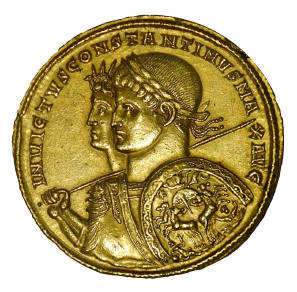
Coin with Constantine and Sol
|
.jpg)
Commemorative coin with She-Wolf Nursing
Romulus and Remus, Mythical Founders of Rome
(330 CE) |
.png)
Medallion with Constantine wearing a Helmet
containing the Chi Rho symbol
(315 CE)
Also,
while several images of Sol appear on the Arch of Constantine, no images of
Jesus or any symbols that can be considered Christian appear anywhere on the
arch (see Wallraff 2001;
Marlowe 2006).
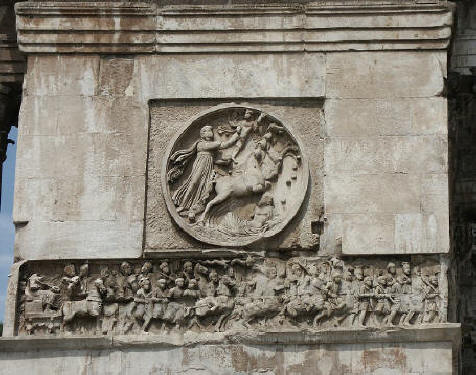
Sol on the east facade of Constantine's Arch
In
describing Constantine's Arch, Wallraff (2001: 256) states rather clearly,
Constantine won his victory over
Maxentius instinctu divinitatis, as the famous inscription on his triumphal arch
reads. It has been debated as to what deity this is referring; in any case there
is no iconographic evidence whatsoever to support a Christian interpretation. On
the other hand, the arch is full of solar symbols. There can be no doubt that at
this stage Sol invictus was at least as important to Constantine as Jesus
Christ.
It is likely, therefore, that the inscription instinctu divinitatis
("inspired by the divine")
displayed prominently on the arch refers to Sol rather than to Jesus.
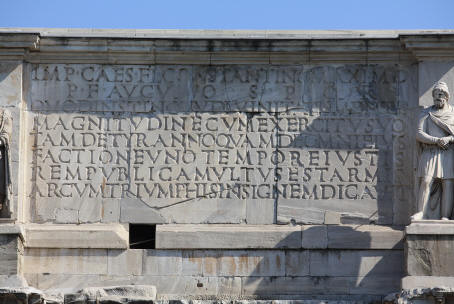
Translation
To the Emperor Caesar Flavius Constantinus, the greatest, pious, and blessed
Augustus: because he,
inspired by the divine, and by the
greatness of his mind, has delivered the state from the tyrant and all of his
followers at the same time, with his army and just force of arms, the Senate and
People of Rome have dedicated this arch, decorated with triumphs.
Marlowe (2006) describes the size and placement of the giant colossus of Sol
(125 feet, if the rays extending from the crown are included) that stood
adjacent to the Constantine's Arch in the Roman Forum. She maintains that the
statue was framed by the arch and that it was situated in such a way as to
dominate the entire landscape of the Forum. Similarly, the
principal forum at Constantinople contained an imposing column some 115 feet
high upon which stood a statue of Constantine portrayed with the attributes of
Apollo, the Greek sun god. The emperor's devotion to the sun was, thus,
evidently alive and well, with no indication that he abandoned the sun god for
Jesus.

Constantine's Column Today
(Istanbul)
How and Why December 25th Became
Jesus' Birthday
Once
it is understood that December 25th was not the original day on which
Christians believed Jesus was born and that this specific date was not
established by the Roman Church until the late fourth century, the question becomes how and why
did December 25th become the official date for celebrating the nativity of Jesus
throughout Western (though not Eastern) Christianity.8 Two explanations have
dominated modern discussions of the issue: one liturgical,
the other historical.9
Thomas J. Talley, an American
Anglican liturgist and a proponent of the liturgical explanation [a.k.a., the
Calculation Hypothesis]
supports the explanation initially presented by Louis Duchesne (1843-1922) in
which
the nativity date
of December 25 was arrived at by computation from the date already established
for the passion in the West early in the third century, March 25. The primitive
pascha celebrated the entire mystery of Christ, including the incarnation, and
christological development early identified the point of incarnation as the
conception at the annunciation to Mary. This would put Christ's nativity nine
months after the March 25 date assigned to the passion and conception, on
December 25.
(Talley 2000: 266)
In other words, a March 25th
conception was followed by a perfect nine-month pregnancy, resulting in a December
25th birth date. The conception date would, thus, have been identical
to
Jesus' death date. Duchesne theorized that the December 25th date was
reached by taking the traditional date of Jesus' death, March 25, and concluding
that it was also the date of his conception, following the numerological belief
that Jesus would have lived an exact number of years. His birth would,
therefore, have occurred on December 25th, exactly nine months after his
conception. Talley (ibid.) supports this hypothesis by claiming that these
dates of conception and death were accepted by Augustine
10
in an early North
African tractate, and were contained in traditions referred to by both John
Chrysostom and Epiphanius.11
Duchesne's thesis is, of course, simply a rehash of the kind of arguments used by early
Christians to justify a whole variety of different birth dates; indeed, his
explanation is essentially a modern retelling of Julius Africanus' thesis in the
early third century (see above).
The
Catholic Encyclopedia,
however, notes that "there is no contemporary evidence for the celebration in
the fourth century of Christ's conception on 25 March,"12 rendering Duchesne's
theory moot.13
According to Cullmann (1956: 22), the
January 6th birth date for Jesus in the East was rationalized in a manner similar to that of December 25th in the
West. January 6th is 9 months after April 6th, which was regarded there as the
date of Jesus' conception and crucifixion. A liturgical explanation for this
date is, therefore, equally problematic.
Inasmuch as beliefs evolve over
time and change from place to place, it is necessary to examine the time and
place that the institutionalization of Jesus' birth date occurred in order to
understand both why a date was established at all, as well as why a specific
date was chosen. In addition, since various dates were proposed and accepted, it
is necessary to understand the process through which one date became canonical
and all others declared heretical. To achieve this goal, it is necessary to
focus on the political conflict that existed among competing Church factions and
the role that the institutionalization of one date to the exclusion of all
others played in the consolidation of the Roman Church's power and authority
over other churches. More
specifically, if we are to understand why Jesus' birth date became
celebrated on December 25th in the West, we
need to explain it systematically; i.e., we must consistently explain:
(1) why the celebration of
Jesus' birth emerged at all;
(2) why it was celebrated on
December 25th initially only in the west; and
(3) why it was originally
celebrated on January 6th in the east.
We also need to understand why these two dates
became significant theological issues in the ongoing conflict between eastern and
western Christianity. In order to achieve such an explanation, we need to
examine the context in which the celebration of Christmas emerged; it did not
occur in a vacuum. To this end, the
promotion and eventual supremacy of the December 25th date for Jesus' birth must be
understood as part of the ecclesiastical politics of the day.
. . . mainline or orthodox
(Nicene) Christians undertook to defend their beliefs against, on one hand
non-Christians of whatever belief system, and on the other hand fellow
Christians in various splinter groups who supported beliefs and practices
condemned by the mainline Church as "heresy." It was in this atmosphere of
polemics and fear for the unity of the Christian movement in the fourth century
that the new feast of Christmas came to be used as a means of promulgating
Nicene doctrine concerning the nature of the incarnation and the equality of the
Son with the Father, while castigating, explicitly or implicitly, both
non-Christian festivals and sun-worship practices, and the threat posed to the
Church from various Christian factions.
. . . by the fifth century
bishops were making use of the feast to counter non-mainline teachings, a
process strikingly visible in the ten consecutive Christmas sermons of Leo I.
(Roll
2000: 278-279)14
Numerous competing Christian sects existed
throughout the Roman Empire. Eventually, it was the church in Rome, with
imperial support, that came to dominate the faith and to define authoritative
Christian beliefs and practices. In the process of Christianity becoming the official religion of the Roman
Empire, and of the Roman church becoming the official Christian authority within
the empire, Western Christianity incorporated into its theology and structure several
beliefs, images and institutions that it borrowed from pagan Roman religious
practice.15 Included
among these were the
establishment of "holy places", a belief in saints (i.e., spirits of departed
individual who, because of their divine status, could assist those still
living), a college of religious officials, and the establishment of a
centrally-controlled calendar of holy days that organized
religious worship throughout the empire (see Helgeland 1980: 1292-1298;
Kraabel 1982: 276; Markus 1994).
Indeed, as
McGowan (2012) points out, "many early elements of Christian worship --including
eucharistic meals, meals honoring martyrs, and much early Christian funerary
art-- would have been quite comprehensible to pagan observers."
Kraabel (1982: 276) similarly comments on the ease
with which the beliefs and rituals associated with "holy places" and religious
worship directed by the imperial Roman calendar
passed "smoothly and
almost unnoticed into a new Roman religion"
(i.e. Christianity).
Indeed, the celebration of Christmas and
Easter, which together incorporate a belief in a virgin birth, the incarnate
union of a male god and a human female, and a divine salvic death and
resurrection, all have precedence in pagan beliefs and practices.16
Roman belief in the deification of individuals is illustrated in
the base of a column currently located in
the Vatican courtyard, which presents the Apotheosis of Antoninus Pius and
Faustina. One of the iconographic features adopted by Christianity from
Greco-Roman paganism was the portrayal of winged divine beings.
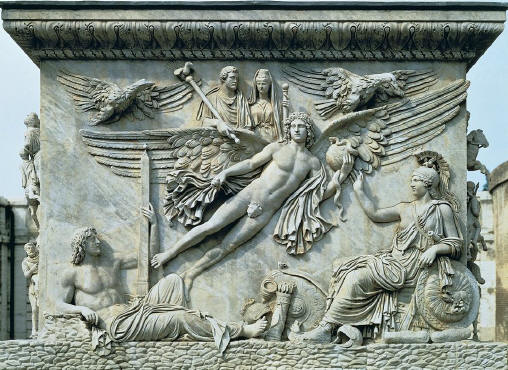
Apotheosis of Antoninus Pius and Faustina
pedestal of the Column of Antoninus Pius
(c.
161 CE - Rome)

Iris the Heavenly Messenger
in Greek Mythology
|
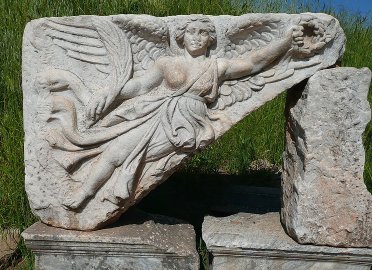
Nike, the
Greek Goddess of Victory
(Ephesus)
|
.jpg)
Winged Victory of Samothrace
(190 BC) |
The Christian image of a winged
angel (below) follows very closely on that of Greek and Roman images of divine
beings.
%20on%20the%20Prince's%20Sarcophagus,%20discovered%20in%20Istanbul%20in%201930%20(4th%20c.)-copy..jpg)
Oldest Representation of a Winged Angel
Prince's Sarcophagus
(Istanbul,
4th century)
Images of Jesus as the
"Good Shepherd" also have precedence in earlier Greek and Roman portrayals.
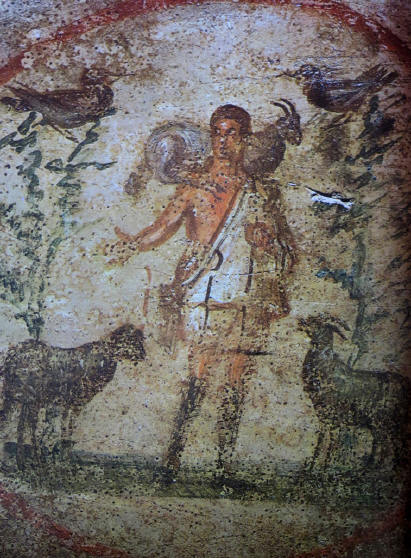
Jesus as
Good Shepherd
(Catacombs
of Priscilla-Rome-3rd century)
Christ as Shepherd of Souls -allegory
originated in image of Moschophoros from
Greek art
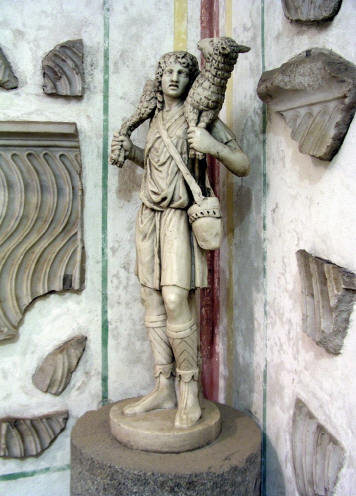
The Good Shepherd
(Domitilla Catacombs - Rome)
|
,%20(Acropolis%20Museum,%20Athens),%20ca.%20470%20BC.jpg)
The Moschophoros
(Calf-bearer),
(ca. 470 BCE)
Acropolis Museum, Athens
|
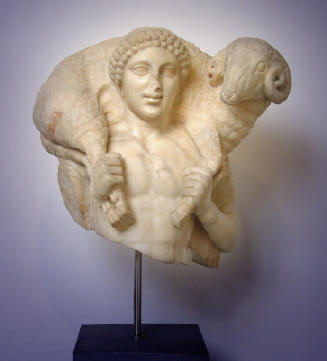
Hermes crioforo
("ram-bearer")
|
Similarly, a
divine birth was attributed to many gods in the ancient world.

Scenes depicting
the divine birth of Amenhotep III
(c. 1390 - c. 1352 BCE)
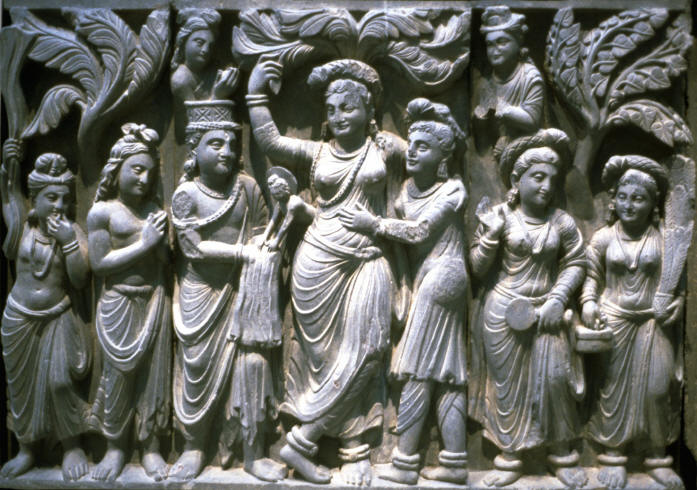
Miraculous Birth of
the Buddha from the side of his mother
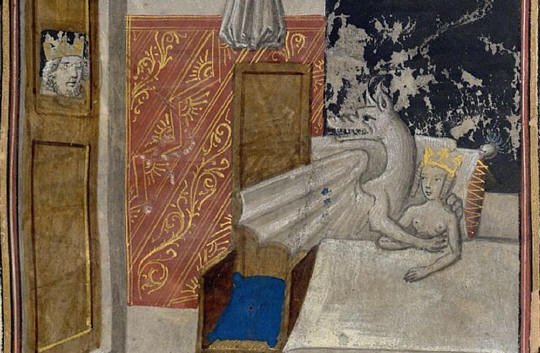
Conception of Alexander the Great 17
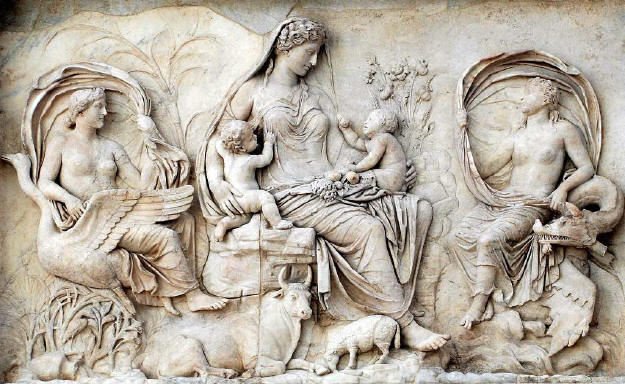
Birth of Romulus
and Remus through the God Mars
impregnating
the Vestal Virgin Rhea Silvia
18
The newly
instituted Christian calendar performed the same social and
political function
as the pagan Roman calendar it replaced: the promotion of imperial unity.
In pagan Rome, December
25th was an important annual festival celebrated in honor of the rising sun, the
supreme deity established by Aurelean and promoted by Constantine, who pursued a
deliberate policy of uniting the worship of the sun with the worship of Jesus.
To this end, the official establishment of Christmas on December 25th followed
logically from the previous imposition by the Roman Church (also under Constantine's
direction) of Sunday as both the "Lord's Day" and the day
for the celebration of Easter.19
The uniformity imposed
on the celebration of Easter went along with the uniformity imposed on the
celebration of "the most honorable day of the sun," which Constantine had set
aside four years earlier as the weekly day of rest (C. Just. III.12).
This also contributed towards unifying the empire --under a monotheistic
sun-religion. While the movement was in the direction of Christianity, the
formulation did not exclude the cult of Sol Invictus. . . . This process,
begun by Constantine, was continued and expanded by later emperors. In 386
explicitly religious reasons were given for reiterating Sunday as a day free of
all business (C. Theod. II.8.18). Finally in 425 the "Church Year" is legally in
place: each Sunday, plus Christmas, Epiphany, Easter and Pentecost are to be
solemn free from circus, theater and other spectacles (C. Theod. XV.15.5). Even
pagans in their "stupidity" and Jews in their "madness" must conform. . .
.
As the empire moved in a Christian direction, so also did the calendar,
including with Christmas.
(Kraabel 1982: 279)
In the newly
established Church
calendar, Christmas functioned originally as a counter to the
Natalis Solis
lnvicti. ("Birthday of the Unconquerable Sun'') on December 25,
which had been
inserted into the Roman calendar by the emperor Aurelean in 274 following his
defeat of Palmyra the previous year (Strittmatter 1942: 613). Under Aurelean, Sol Invictus
became the supreme deity in the Roman pantheon, and the traditional day of the
winter solstice, bruma (December 25), became the
Natalis Solis lnvicti,
the paramount feast in the calendar of the Empire (the
sun, "born" on that day, "grew" every day thereafter). At the same time,
Aurelean
dedicated a magnificent temple to the newly established supreme god in the
Campus Agrippae and formed a priestly college of senatorial rank (perhaps a
model for the College of Cardinals in the Roman Church) charged with
the responsibility of serving this new supreme deity (Strittmatter 1942: 613). Numerous Roman gods
had been associated with the sun at one time or another.
Macrobius (Saturnalia
1 17-23, c. 400) argued that Apollo, Bacchus, Mars, Mercury, Asclepius,
Hercules, Adonis, Osiris, Saturn and Jupiter had all at one time or another been identified with the
sun. However, under Aurelean, Sol Invictus became the supreme deity.
Ultimately,
the emperor Julian even wrote a lengthy
Hymn to King Helios
during his brief reign (361-363)
(Kraabel 1982; 278).
One by one, a whole series of divinities -Apollo,
whose numerous epithets are carefully reviewed; Liber or Bacchus, Mars,
Mercury, Aesculapius, Hercules, Adonis, Osiris, Saturn, Jupiter-are identified
as one deity, the Sun. It is not insignificant that the last Pagan emperor of
Rome should have left us an elaborate panegyric on this divinity, whose
spiritual offspring he believed himself to be.
(Strittmatter 1942: 613-614)
Worship of the
sun eventually passed to Mithras, the new
rising god who, while initially considered Sol Invictus' ally, eventually
replaced him as the paramount Roman solar deity. As
Christianity arose and competed with
Mithraism for both adherents and influence
during the third and fourth centuries (with Jesus serving as Rome's
most recent incarnation of sun worship),
Mithraism became a particular focus of Christian hostility.
Jesus and the Rising Sun
As Christianity spread from
its Palestinian homeland into the wider Roman Empire, it encountered numerous
other religions with which it had to compete and whose beliefs it would have had
to confront or accommodate, if it was to succeed.
First and foremost was the official religion
of the empire, which had shifted towards the primary worship of the Sun at the
head of a pantheon of gods, especially, as indicated above, after the emperor Aurelian (270-275
CE)
promoted Sol Invictus to the position of a monotheistic state god and
established December 25th as the day to celebrate Sol Invictus'
birth (McGowan 2012).
As the Christian Church
pursued religious leadership in the Empire, it would have been in the Church's
interest to make that transition as easy as possible in order to convert Roman
pagans. Linking Jesus' birth with that of the sun would have been central to
that process. Consequently, it would have been useful to link Jesus to the sun,
as was done for several previous Roman gods (see
Macrobius Saturnalia
1 17-23, op cit.).
Linking Christ with the Sun did, in fact, occur early in the development of Christian thought.
Constituting a form of
solar christology, Christ was
frequently
represented as the sun; indeed, among his titles was
Sol iustitiae, ["Sun of Justice"] (Roselaar (2014: 204).
By the middle of the
second century the term 'Sunday' replaced the former 'Lord's Day', indicating
that in Christian thought the resurrection of Christ had already become
associated with the symbolism of the sun.
Those who argue for the derivation of Christmas from Aurelian's solar festival
on the winter solstice regularly appeal to that image of Christ as Helios,
driving the chariot of the Sun across the heavens, as evidence for the
identification of the date of Christ's birth with that of the Sun.
(Talley 2000: 269)
|
_(1499-1500).jpg)
|
Sol Iustitiae
("Sun of Righteousness")
Albrecht Durer
1499/1500
National Gallery of Art
Washington, DC
|
Christian tradition eventually assigned the
birthdays of John the Baptist and Jesus to the summer and winter solstices
(June 24th and December 25th) respectively, having John born on the day from
which the sun
decreases and Jesus born on
the day from which it
increases (see Winter
1955:235, note 15). This association of John and Jesus with the changing
position of the sun continued the increasing theological linkage and
subordination of John to Jesus initiated in and elaborated through the four
canonical gospels (see Abruzzi,
The Birth of Jesus).
The Venerable Bede
(673-735) in his
De temporum ratione
(725), an influential medieval source for calculating Easter and other
significant dates in biblical history, more precisely defined Christian
beliefs regarding the births of Jesus and John by placing them within ancient
Roman calculations for the solstices and equinoxes. In Bede's reckoning, Jesus
was conceived and crucified on the 8th kalends of April [March 25], at
the
spring equinox. and born on the 8th kalends of January (December
25th) at the
winter solstice, while the Baptist was conceived at the
autumn
equinox on the 8th kalends of October [September 24] and born at the
summer solstice on the 8th kalends of July [June 24] (see Nothaft
2011: 507). Nothaft (ibid.) adds that other sources existed that also applied the symbolism of increasing and decreasing light associated with
the births of Jesus and John respectively. One source, claiming to have been
written by John Chrysostom himself, maintained that this symbolism was already
suggested in the Gospel of John (3:30) where John the Baptist, referring to
Jesus, is quoted as saying,
"He must increase; I must decrease."
According to Roll (2000: 289),
several early patristic writings contained references to Jesus as representing
the light or the "new sun".
The oldest extant
liturgical texts for Christmas are found in the Veronensis and include nine sets
of formularies which link the themes of light and the birth of Christ. The
opening prayer for Mass at midnight in the contemporary Roman Missal, based on
the Gelasian Sacramentary, echoes the theme of Christ as light, and implicitly
the "true sun" of the world.
(Roll 2000:
289)
As
mentioned previously, the author of
De Pascha
Computus
writing in 243, attempted to link
Christ's birth with that of the Sun. Ambrose (c. 339-397), bishop of Milan, described Christ as
"the true sun, who outshone the fallen gods of the old order" (McGowan 2012),
and in a Christmas sermon stated,
Well do Christian people call this holy day, on
which our Lord was born, the day of the new sun; and they assert it so
insistently that even Jews and pagans agree with them in using that name for it.
We are happy to accept and maintain this view, because with the dayspring of the
Saviour, not only is the salvation of mankind renewed, but also the splendour of
the sun. (quoted in Cullmann 1956: 36)
Pope Leo the Great (440-461) also employed
analogies of Jesus with light and with the sun in several of his Christmas
sermons, contrasting him to the "darkness" represented by one or another
non-Christian religions and heretical Christian sects (Roll 2000: 289).
Augustine
alluded to the pagan festival of December
25th in his summons to Christians not to worship the sun on this day, like the
pagans, but him who created the sun (Cullmann 1956: 31).
Similarly, in his Christmas
sermon in 386, John Chrysostom, archbishop of Constantinople, preached,
"Let us rejoice, therefore, and
exult, beloved. For if John in his mother's womb leaped at Mary's coming to
Elizabeth, much more ought we, who have seen not Mary, but our Saviour born this day to leap and exult, to marvel and stand amazed over the magnitude of God's
dispensation, which exceeds all thought. For consider how great a thing it would
be to behold the sun descended from heaven and running about the earth,
emitting hence its rays to all. But if in the case of a visible body of light
this occurrence would strike all beholders, reflect with me and consider what
it is to see the Sun of Righteousness sending forth His rays from our flesh and
illuminating our souls. (quoted in Strittmatter 1942: 600)
20
Talley (2000) points out
that even Constantine, who himself converted to Christianity and, in the process,
became instrumental in Christianity becoming the official religion of the
empire, made an explicit connection between Jesus and the sun.
That the emperor . . .
[Constantine] . . . intended the new capital to be a clearly Christian city did
not mean that he had renounced his devotion to the Sun. At Constantinople, the
principal forum was adorned with a porphyry column upon which stood a figure of
Constantine with the attributes of Apollo. The emperor's solar piety was
evidently alive and well, but did he there, as he is said to have done at Rome,
seek to associate the nativity of Jesus with that of Sol Invictus? . . . It
seems beyond dispute that in some sense or other Constantine associated Christ
with the Sun, as had many before him on the basis of Mal 4:2. Such
identification of Christ as "Sun of Righteousness" found iconographic expression
at Rome in a famous mosaic ceiling in the tomb of the Julii in the Vatican
necropolis
(Talley 2000:
268-269).21
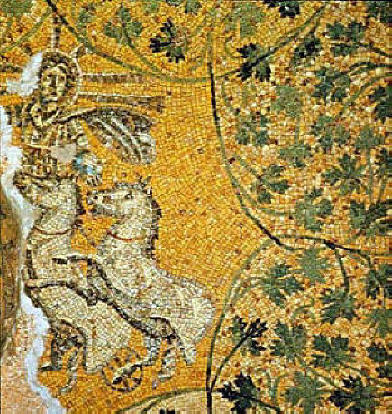
J
esus
as Helios
(Tomb of
Julii, Vatican Necropolis)
22
Several
scholars have further argued that the adoption by the Christian Church of pagan
Roman religious practices and institutions, most importantly those associated
with the worship of the sun, was not coincidental. Several early Christian authorities
were well aware that they were adopting a traditional Roman midwinter
ceremony as Jesus' birthday and encouraged their congregations in this regard. As Cullmann (1956: 31) points out, the numerous statements made by early ecclesiastical authorities "show
that the fixing of the festival of Christ's birth on December 25th was not done
in ignorance of the pagan significance of the day."23 Indeed, in a
sermon attributed to Maximus of Turin (c. 465), the bishop called for the
explicit adoption by Christians of the Roman celebration of the birth of the
sun.
The common people do
well, indeed, to call this birthday of our Lord the 'new sun,' and make the
assertion with such emphasis that Jew and Gentile find themselves in agreement
in this terminology. Let us willingly make this custom our own, for with the
Saviour's rising not only the salvation of the human race, but also the radiance
of the sun itself is renewed. (quoted in
Strittmatter 1942: 616-617)
It was also not a
coincidence that Sunday, named for the sun and reserved in Roman religion for
the worship of the sun, was adopted by Roman Christianity as the day to worship
Jesus and to celebrate his resurrection. Jesus replaced all previous Roman solar
deities as the personification of the sun and the one god integral to the
emergence of the Christian calendar, which completely replaced the previously
dominant Imperial calendar.
The Sun God was then
the official supreme deity of the empire taken over by Constantine. The
Christmas festival was inaugurated with the ''triumph of Christianity," to
supplant this cult of the sun with another. From the Christian side, this
process was aided by prior developments in christology including the application
of the term ''Sun of Righteousness" (Mal. 4:2) to Christ. The earliest instance
is apparently in chap. XI of_ the Protreptikos of Clement of Alexandria, who
died ca. 215. It occurs in a passage from de Pascha Computus (AD 243) quoted at
the beginning of this essay. It is then frequently in Origen and later writers.
When these texts are put together with others which use sol or helios of Christ
without direct reference to the Malachi text, it becomes clear that a kind of
solar christology was developing which could be pointed in the same direction as
the cosmic piety represented by Sol Invictus. (see Strittmatter, pp. 614-617). .
. . What happened to December 25, however, is a good deal more than the
replacement of one sun-god or sun-festival with another. What was done was not
only to change a single holiday but rather to impose the essentials of an entire
Christian calendar on the Roman empire. (Kraabel 1982: 278)
At the same time, while
several early Christian leaders actively borrowed the traditional Roman mid-winter
ceremony to serve as the celebration of the birth of Christ, some expressed
concern regarding the incomplete separation of the two festivals.
Admonitions like those of
Augustine and Pope Leo had now clearly become necessary, for this deeply-rooted
pagan festival of the 'unconquered sun god' did not, in fact, simply disappear,
but persisted in many practices which passed over into the Christian festival.
So when Christmas was separated from another Christian festival, that of
Christ's baptism, it fell under the influence of a pagan one. At first this
influence was felt in Christian customs. We learn, for instance, from a Syrian
theologian that Christians also now began the practice of lighting bon fires on
this day.
(Cullmann 1956: 32)24
Pagan Romans
had also
introduced the mid-winter holiday of
Saturnalia
into the annual calendar, which was celebrated from December 17-25.
Throughout this celebration,
Roman courts were
closed, and Roman law dictated that no one could be punished for damaging
property or injuring people during the weeklong celebration. The festival began
when Roman authorities chose "an enemy of the Roman people" to represent the
"Lord of Misrule." Each Roman community selected a victim whom they forced
to indulge in food and other physical pleasures throughout the week. At
the festival's conclusion (December 25th), Roman authorities believed
they were destroying the forces of darkness by brutally murdering this innocent
man or woman.
(Judaism
Online).25
During the 4th
century, Christianity imported the Saturnalia festival in an effort to
convert the pagan masses. Christians had little success, however, in refining
the practices of Saturnalia. According to Nissenbaum (1997: 4),
In return for ensuring
massive observance of the anniversary of the Savior's birth by assigning it to
this resonant date, the Church for its part tacitly agreed to allow the holiday
to be celebrated more or less the way it had always been.
26
The scholarly consensus
today, then, is that the celebration of Jesus' birth was moved to
December 25th in order to both counteract and accommodate pagan
beliefs and practices, most notably the Roman celebration of the
Dies natalis solis invicti,
the annual ritual celebrating the rebirth of the Sun (the winter
solstice).
By
celebrating Jesus' birth on December 25th, and placing it within its holy
calendar, the Church effectively replaced and co-opted a pre-existing pagan
holiday that was embedded within the former Imperial Roman calendar. In the
process, the Church associated Jesus with a whole variety of attributes (most
notably his association with the sun, his representation of the victory of light
over darkness, and his purported miraculous birth) that had been attributed to
existing (and competing) pagan high gods, most notably Sol Invictus and Mithras, the most recent personifications of Imperial
Rome's paramount god. It is also clear that Church leaders were well aware of
the adaptations they were promoting.
Several
sources have over the centuries acknowledged that the Roman celebration of the birth of the sun
served as
the basis for choosing December 25th to commemorate the birth of Jesus. A note inserted into a manuscript written by the Syrian, Dionysius Bar-Salibi,
in the late 12th century (apparently by someone other than Dionysius)
offered the following explanation for why the Nativity is celebrated on December
25th.
The Lord was born in the
month of January, on the day on which we celebrate the Epiphany; for the
ancients observed the Nativity and the Epiphany on the same day. . . . The
reason for which the Fathers transferred the said solemnity from the sixth of
January to the twenty-fifth of December is, it is said, the following: it was
the custom of the pagans to celebrate on this same day of the twenty-fifth of
December the feast of the birth of the sun. To adorn the solemnity, they had the
custom of lighting fires and they invited even the Christian people to take part
in these rites. When, therefore, the Doctors noted that the Christians were won
over to this custom, they decided to celebrate the feast of the true birth on
this same day; the sixth of January they made to celebrate the Epiphany. They
have kept this custom until today with the rite of the lighted fire.
(see
Roll 2000: 280)
The Reverend Increase
Mather of Boston offered a similar explanation in 1687.
The early Christians who
first observed the Nativity on December 25 did not do so thinking that Christ
was born in that Month, but because the Heathens' Saturnalia was at that time
kept in Rome, and they were willing to have those Pagan Holidays metamorphosed
into Christian ones.
27
In
fact, it was its link to paganism, in particular the
celebratory excesses associated with the holiday,
that resulted in strong Puritan opposition to the celebration of Christmas.
In his
An Anatomie of Abuses
(1583), Phillip Stubbes, an
English Pamphleteer, wrote disapprovingly,
That more mischief
is
that time committed than in all the
year besides, what masking and mumming, whereby robbery whoredom, murder and
what not is committed? What dicing and carding, what eating and drinking, what
banquetting and feasting is
then used, more than in all
the year besides, to the great dishonour of God and impoverishing of the realm.
(Durston 1985: 8)
The observance of Christmas was
generally banned by the Puritans and was even made illegal in Massachusetts
between 1659 and 1681, due to its perceived pagan origins (see Kraabel 1982: 279; Nissenbaum 1987: 3). According to Kraabel (ibid.), classes were
not cancelled in Boston public schools on December 25th, and "any student staying home to celebrate Christmas was severely punished."
A second and equally
important basis for the deep-seated Puritan objection to the celebration of
Christmas was the holiday's association with the Roman Catholic
Church. In its First Book of Discipline,
published in 1561, the newly founded
Kirk ("Church") of Scotland rejected those holidays not present in the
Scriptures, which they considered "Papist" inventions. It listed Christmas among
the many
holy dayis of certane
Sanctis commandit by man, suche as be all those that the Papistis have invented
. . . [and which] . . . becaus in Goddis Scripturis thai nather have
commandiment nor assurance, we juge thame utterlie to be abolischet from this
Realme. (Laing 1846-64: 185-186; quoted in Nothaft 2011: 504)
The prolific Pamphleteer,
William Prynne (1633), also denounced Christmas as a Papist repackaging of
ancient Roman rites.
If
any here demaund, by whom these Saturnalia, these disorderly Christmasses &
Stageplayes were first
brought in
among the Christians? I answer that the paganizing Priests and Monks of popish
(the same with the heathen Rome) were the chiefe Agents of this worke.
(quoted in Nothaft 2011: 521)
The Puritan "War on
Christmas" (see Durston 1985, 1996) was
inextricably connected to the English Civil War (1642-1651), which pitted Protestants
against Catholics. According to Durston (1985: 8),
The celeb
ration
of Christmas thus became just
one facet of a deep religious cleavage within early seventeenth-century
England which, by the middle of the century, was to lead to the breakdown of
government, civil war and revolution.
When the Puritans took control of government in the mid-1640s they made a
concerted
effort to abolish the Christian festival of Christmas and to outlaw the
customs associated with it . . .
Western vs. Eastern Dates for the Nativity
Church leaders in the late 4th century had to employ
considerable pressure throughout the eastern empire to get Christians to celebrate
the birth of Jesus on December 25th.
Significant local opposition existed to the imposed date, due in large part to
the fact that the
Epiphany,
celebrated on January 6th,
already held a traditional place in the eastern liturgical calendar as the feast
of the Incarnation
(Roll 2000: 276). While John Chrysostom succeeded in establishing the December
25th date in Constantinople in 379, and shortly thereafter in Cappadocia and
Syria (Strittmatter 1942: 604), other churches throughout the eastern empire
resisted. Egypt (Alexandria) did not capitulate until 431.28
The Church in Palestine held out even longer; it was not until the middle of the
6th century that the Jerusalem Church abandoned its opposition to the December
25th date (Cullmann 1956: 33; Kraabel 1982: 277). The Armenian Church completely
refused to adopt the new date and continues to celebrate both the Nativity
and Baptism on January 6th.29
Significantly, the January 6th birth date was rationalized in the East using the same
theological arithmetic as was employed to justify the December 25th date in the West.
January 6th is 9 months after April 6th, which was in the East regarded as
the date of Jesus' conception and crucifixion (Cullmann 1956: 22).
The
celebration of Jesus' birth on January 6th long pre-dated that of December 25th.
The January 6th date was celebrated throughout the eastern empire, including in
Palestine, the very land where Jesus lived. The Gnostic followers of Basilides
were celebrating the birth of Jesus on January 6th as early as the 2nd
century, and likely before 160 (Kraabel 1982: 275). January 6th
was still being celebrated as Jesus' birth date in the mid-4th
century in Gaul and in Spain, and there is no evidence for the celebration of the
nativity on December 25th
in Gaul [present-day France]
before 400 (Strittmatter 1942: 609). According to Cullmann (1956:
25-26), an early 4th century Egyptian papyrus exists, which is "the oldest
Christmas liturgy we possess, and in
it Christmas is still observed on the night of January 5th-6th."
The papyrus contains the liturgical formula for a church choir celebrating the
feast of the Epiphany on January 5th-6th, the date when Jesus' baptism in the
Jordan was celebrated. However, a segment of the papyrus contains instructions
for that part of the festival celebrating Jesus' birth and includes an account
of the birth in Bethlehem, the flight to Egypt, and the return to Nazareth.
January
6th was, thus, celebrated quite differently
in the eastern and western churches. Whereas only the story of the star and the
visitation of the Magi was observed on that date by the Roman Church (Cullmann
1956: 26),30
Jesus' birth, his baptism, the visitation of the magi, and the wedding feast of
Cana were all celebrated on January 6th in the eastern church. At the same time, in
Gaul and Spain January 6th was the day to commemorate the Nativity, the Baptism,
and Miracle of Cana and even, at times, the Multiplication of Loaves and Fishes
(Kraabel 1982: 275). Furthermore, Strittmatter notes that, while the Roman mass
book for January 6th only celebrates the visitation of the Magi, the Baptism and
the Miracle of Cana are both mentioned in the
Breviary,
where Stanzas 8, 9, 11, & 12 of Sedulius' hymn,
A solis ortus cardine
sung at Vespers
concern the adoration of the Magi, the Baptism of Christ, and the miracle of
Cana (Strittmatter 1942: 626, note 93).31
The feast of the Epiphany was celebrated with
great splendor in Palestine. According to Cullmann (1956: 27-28),
The well-known account by
the noble pilgrim Aetheria (Egeria), who spent 3 years in Palestine.
*
She could not find words adequate to describe the magnificence of the of the
festival. She tells how all, along with the bishop, repair in solemn procession
to Bethlehem on the night of January 5th-6th in order to
hold a service at night in the cave where Jesus was supposed to have been born.
Before daybreak, the whole procession moved off to Jerusalem. As January 6th
dawns, they reach Jerusalem and enter the Church of the Resurrection, whose
interior is illuminated with thousands of candles. They depart the church and
reassemble by mid-day.
* Etherie, , "Sources
chretiennes," Journal de
Voyage. Paris 1948,
p. 203 ff.
Cullmann
(1956: 27) also notes that the Syrian
Church Father, Ephraem (306-373) called the January 5-th-6th
festival the most sublime of Christian festivals and stated that on the eve of
January 6th every house was decked with garlands. According to Cullmann (ibid.),
Ephraem rejoiced at the nocturnal festival.
"The
night is here" he says, "the night which has given peace to the
universe! Who would sleep on this night when the whole world is awake!"
According to
Ephraem, the evening festival celebrated the birth of Christ, including the
adoration of the shepherds and the appearance of the star, while the
following day was dedicated to the adoration of the magi and to the baptism
of Christ in the Jordan. (ibid.)
The whole creation
proclaims,
The Magi proclaim,
The star proclaims:
Behold, the king's son is here!
The heavens are opened,
The waters of Jordan sparkle,
The dove appears:
This is my beloved son!
An
important element in the conflict over
celebrating Jesus' birth on December 25th vs. January 6th concerned the issue of
when Christ became incarnate.
The Orthodox (Roman) view was that the human and the divine came together in
Jesus at his birth. Early Gnostics, on the other hand, believed that Christ first appeared on earth
at Jesus' baptism, which they celebrated as the
Epiphany,
from the Greek epihaneia
("appearing"). The feast originally had nothing to do with the birth of Jesus as
told in the gospels of Matthew and Luke, but rather relied on Mark's gospel in
which the divine spirit first enters Jesus at his baptism (Mark 1: 10-11).32
The notion that Christ "appeared" instead of
being born was a widespread belief among early Christians. Gnostic Christian
texts virtually eliminated any belief in a human origin for Jesus. For Gnostics,
Christ was a spirit who inhabited a human body, not the body itself. It is also
significant that no birth story exists in the
Gospel of John,
which states simply, "In the beginning was the
Word . . . And the Word became flesh and dwelt among us"
(see John 1: 1-14). Similarly, in the second-century
Protevangelium of James,
the infant Jesus first appears in a bright cloud.
And they stood in the place
of the cave,
and behold a luminous cloud overshadowed the cave. And the midwife
said: My soul has been magnified this day, because mine eyes have seen strange
things -- because salvation has been brought forth to Israel. immediately the
cloud disappeared out of the cave, and a great light shone in the cave, so that
the eyes could not bear it. And in a little that light gradually decreased,
until the infant appeared, and went and took the breast from His mother Mary.
And the midwife cried out, and said: This is a great day to me, because I have
seen this strange sight. And the midwife went forth out of the cave, and Salome
met her. And she said to her: Salome, Salome, I have a strange sight to relate
to thee: a virgin has brought forth -- a thing which her nature admits not of.
(Protevangelium
of James:
19)33
Gnostic belief in the exclusive spirituality of Jesus' existence (
Docetism)
led many Gnostic Christians to adopt the Egyptian god Osiris' birth as a model
for the birth of Jesus. Osiris' birth was
celebrated on January 6 and was marked by a heavenly voice crying,
"The Lord of all comes forth
into the light"
(Plutarch. ls.et Os.
355 E.; quoted in Kraabel 1982: 275).
Hippolytus reported on Basilides' version of the Christmas story,
The light came down from the
Seven upon Jesus the son of Mary, and he was illuminated and set on fire by
the light which shown upon him.
(ibid.)
This belief stood in direct conflict with the
Imperial Roman Church, which fought against
Arianism,
Nestorianism,
Gnosticism
and all other forms of docetism. At the
Council of Nicaea
(325), the Church established Jesus' humanity as canonical, declared any form of
Docetism as heretical, and expressly denounced any doctrine which denied that
Jesus became incarnate at his birth. The
Council of Constantinople
(381) reaffirmed the declarations made at Nicaea and established as canonical
the Trinitarian
doctrine proclaiming the equality
of the Father, Son and Holy Spirit, finalizing the Church's doctrinal position
on the humanity of Jesus.34
The
January 6th date had other precedents in pagan ritual. As previously discussed,
early Christians associated Jesus with the sun and with the bringing of light to
the world (cf. Matt 5: 14; John
8: 12, 9: 5, 11: 9; 2 Corinthians 4: 4). This
facilitated Jesus' replacement of Sol/Mithras in the December 25th nativity
celebration in Rome. The concept of
light played a central role in the celebration of Jesus' birth on January 6th as
well. A feast of Dionysus (son of Zeus), associated
with the lengthening of the day was celebrated on January 6th
(Cullmann 1956: 25). January 6th was
also the date on which the lengthening of the days was celebrated by pagans in
Alexandria at the birth of Aeon
to the maiden, Kore (Cullmann 1956: 28). Strittmatter (1942: 618-619) describes
in detail an Egyptian ceremony honoring the virgin birth of Aeon on this date
and indicates that similar celebrations took place elsewhere, including at Petra
and Elousa.
In
addition, on the night before January 6th the waters of the Nile were
believed to possess special miraculous powers (Cullmann 1956: 25).
Strittmatter (1942: 621-623) states
that Pagans, Christians and Jews all celebrated January 6th with a
ritual dedicated to its "Magical Water." Plutarch linked this ritual to the cult
of Osiris. Both Pliny the Elder, and Pausanias describe a fountain in the temple
of Dionysus on the island of Andros from which wine gushed forth on the feast of
the god on the Nones
(the 5th of January). Epiphanius, the bishop of Salamis, Cyprus (365-403) and a
native of Palestine, claimed that the ritual celebrated the miracle of Cana in
which Jesus changed water into wine. John Chrysostom, on the other hand, asserted that it
commemorated Jesus' baptism, which by
"His descent into the Jordan, Christ hallowed
the waters." The fact that
Epiphanius and Chrysostom offered conflicting explanations of the same ritual
suggests the ritual pre-dated its Christian application. The ritual's
pre-Christian origin is further suggested by the fact that the blessing of the
waters, which was to become such a conspicuous feature of the liturgy of this
feast, is not mentioned by any Christian writer before the fourth century (ibid.).
By
choosing January 6th to celebrate several significant events in the life of
Jesus, most notably his birth, the Egyptian Church gained the same result as that
achieved by the Roman Church through its celebration of Jesus' birth on December 25th.
It co-opted and replaced an important and deeply embedded
pagan festival in order to promote Jesus as the new universal god. The only
difference is that, because the Roman
and Alexandrian churches had
to accommodate distinct pre-existing pagan beliefs and practices in
their respective regions, the Roman Church celebrated
Jesus' birth on December 25th, while the Egyptian Church commemorated it on
January 6th.
The
celebration of different dates for the birth of Jesus became one of the
doctrinal issues
that divided the early Church. The
Roman Church had a theological need to separate the Nativity from the Epiphany;
by enforcing the December 25th date, the Roman Church not only co-opted a Roman pagan festival,
it also negated the legitimacy of the January 6th celebrations and, by
extension, the authority of the Alexandria Church, which led the opposition to
the Roman Church's quest for political and ecclesiastical hegemony (see Baynes
1926; Hardy 1946). Many Christian communities fought the imposition of Roman
orthodoxy, causing major rifts within
the Church, one part of which involved the
celebration of Jesus' birth.35
These rifts resulted in substantial, frequently violent conflicts between
competing Christian communities, especially during the fourth and fifth
centuries. Numerous
sources examine the political conflict that raged among competing factions
in the early Church and the extent to which that competition resulted in
violent confrontations and the calling of ecumenical councils by opposing
factions in order to counter the rulings of councils called by their opponents.
(see Baynes 1926; Bauer 1934;
Jones 1959; Betz 1965;
Frend 1972; Grant 1975; Gregory 1979;
Jenkins 2011; Palmer 2014).
Several sources specifically examine the conflict between the
Eastern Church (led by Alexandria) and the Western Church, centered initially in Rome and later
in Constantinople (see Baynes 1926; Hardy 1946; Haas 1991; Jenkins 2011: passim).
Bart Ehrman (1993) provides a skillful analysis of how the theological
controversies that plagued the early Church resulted in the Roman (Orthodox)
Church altering the original meanings of several New Testament texts to more
closely support its theology over that of competing factions within the
Church, "corruptions" that have survived to the present day as canonical New
Testament scripture.
As
indicated, a significant focus of this conflict
centered around the competition between the patriarchates of Alexandria and Constantinople, which served as the principal representatives for Eastern and Western
Christianity respectively (Baynes 1926; Hardy 1946; MacCulloch
2009: 215-240).36
The Egyptian Church was the leader of the monophysite faction in the
monophysite-miaphysite controversy37
that divided the Church into frequently violent, mutually opposing factions during the 5th century.
Murder, assassination and clergy-led mob violence were all part of the
turbulence that characterized the 5th century (see Frend 1972). In this
ecclesiastical conflict, monophysitism served as a fundamental ideological identifier of Egyptian
opposition to Roman rule. Conflict over competing dates for the birth of Christ
would have been subsumed within this larger theological debate, and as the
Western (Roman) Church defeated the Eastern Church for supremacy within the
empire, its dating of Jesus' birth won out over that promoted by the Egyptian
Church. The Third Canon
of the Council of Constantinople
(360) had raised the see at Constantinople to the second position in the Church,
after that of Rome, since Constantinople was now the "new Rome", i.e., the new
capital of the empire. The intensity of the conflict between the two competing
patriarchs (Chrysostom and Theophilus) reached such a peak that both attempted
to have the other declared a heretic.
The
Council of Chalcedon (451),
marked the final victory for the patriarch of Constantinople over Alexandria,
and thus the supremacy of the Western Church and its theology. Dioscorus, the
existing Patriarch of Alexandria, was deposed by the Council and replaced by
Proterius, chosen by Constantinople. This victory of Constantinople and its
theology produced a violent reaction in Alexandria.
Nothing could secure the real
acceptance at Alexandria of a bishop imposed from without after the deposition
of their own Patriarch. The imperial emissaries found the city in full revolt
and lost two thousand men to the insurgents; only reinforcements sent post haste
from Constantinople were able to establish Proterius uneasily on the patriarchal
throne. (Hardy 1946: 92-93)
Proterius' tenure as the
Patriarch of Alexandria did not last very long, however. He was lynched in the baptistery
of the Caesareum in 457 (Hardy 1946: 93), and his body
torn to pieces by an Alexandrian mob (Frend 1972: 26).
Gradually, the
Roman Church's power and its Orthodox theology came to dominate the empire, most
notably following Theodosius' edict in 381 proclaiming (Roman) Christianity
as the official religion of the Roman Empire. This put the full force of the empire behind the Roman Church in its
battle to define and control Christian orthodoxy (see Kraabel 1982: 277-279). The
Church's eventual hegemony within the empire and its elimination of most competing Christian factions was
thereafter assured by the support
it would receive from successive Roman (and later Byzantine) emperors (cf. Luibheid 1965;
Cleve 1988).
The
celebration of Jesus' birth on December 25, thus, spread outwards from Rome until it
replaced the January 6th celebration throughout most of Christendom.
* *
* * *
NOTES
1. McGowan (2012) maintains that
Easter was originally celebrated as a Jewish Christian reinterpretation of Passover,
becoming a distinctly Christian feast by the mid-second century CE where an
"apocryphal text known as the
Epistle to the Apostles has Jesus
instruct his disciples to 'make commemoration of [his] death, that is, the
Passover.'"
2.
Neither Matthew's nor Luke's birth narratives
has any historical
validity. They are theological, not historical, documents (see Abruzzi,
The Birth of Jesus;
When Was Jesus Born?)
3.
Many contemporary Christians, including the late
Joseph Fitzmyer
SJ (former
Professor of Biblical Studies at
the Catholic University, member of the Pontifical Biblical Commission and
president of the Catholic Biblical Association)
have placed Jesus' birth
on September 11, 3 BCE (cf.
When Was Jesus Born. Bible Says Septembeer 11, 3 BC).
Fitzmyer's comment on the date of
Jesus' birth is contained In the Catholic Church's official commentary on the
New Testament.
4.
Tertullian
(Adversus
ludaees c. 207 CE) is the earliest known
author to assign March 25 as the day of Christ's death (Cullmann 1942:
612, note 41).
5. The Donatists
were a Christian sect that emerged in Rome's Africa Province (North
Africa) following the persecutions of Christians by the Emperor Diocletian
(303-305
CE), and which persisted for a little more than a century. The Donatists
were followers of
bishop Donatus Magnus, who first appeared
in Church records in 313 CE as Donatus of
Casae Nigrae.
At that time, Pope Miltiades
pronounced him guilty of re-baptizing clergy who had lapsed and of forming a
schism within the Church. The
Donatists were highly critical of the Church for readmitting Christians
who renounced their faith during the Diocletian persecutions.
The Donatists
contended that such
traditores
could not be reinstated without being re-baptized and re-ordained.
They
also refused to accept the legitimacy of sacraments performed by traditore
priests and bishops readmitted into the Church until they had been both
re-baptized and re-ordained. The Catholic Church continues to refer to
Donatism as a significant, if somewhat short-lived, schism within the Church
(see Catholic
Encyclopedia).
6.
Cullmann (1956: 29, note 13) argues that Augustine's criticism of
the Donatists failure to observe January 6th does not imply that
they celebrated Christ's birthday on December 25th.
7.
Ab Urbe Condita (AUC),
"from the founding of the city" [Rome], 722 BCE in the modern calendar. All
Roman dates were calculated AUC. The year, 743 AUC, corresponded to 11 BCE in
the modern calendar.
8.
December 25th became
the accepted date for the birth of Jesus in the western Roman Empire only. January 6th
was retained in the east for many years, where it was not originally associated with the magi
alone, but with the entire nativity story (see discussion below).
9.
According to Roll (2000: 273), these two alternative
explanations have persisted at least since a debate on the topic was organized
by the
Abt-Herwegen-Institut in
1949, though with less competitive and mutual exclusiveness than initially
presented. The debate, according to Roll (2000: 273-274) has demonstrated
a somewhat nationalist orientation, with American and Anglo-Saxon scholars
tending to support the liturgical explanation and German and other Continental
scholars generally preferring the historical explanation.
10.
According to
McGowan (2012), Augustine in his sermon
On the
Trinity
(Sermon 202, c. 399-419) wrote
For he [Jesus] is believed
to have been conceived on the 25th of March, upon which day also he suffered; so
the womb of the Virgin, in which he was conceived, where no one of mortals was
begotten, corresponds to the new grave in which he was buried, wherein was never
man laid, neither before him nor since. But he was born, according to tradition,
upon December the 25th.
11.
Cardinal Joseph Ratzinger,
writing before he became Pope Benedict XVI, supported the liturgical view in
his
Spirit of the Liturgy
(Ratzinger 2000: 107-109).
12.
The
full text:
The
Astronomical Theory
Duchesne (Les origines du culte chrétien, Paris, 1902,
262 sqq.) advances the "astronomical" theory that, given 25 March as Christ's
death-day [historically impossible, but a tradition old as Tertullian (Adv.
Jud., 8)], the popular instinct, demanding an exact number
of years in a Divine life, would place His conception on the same date,
His birth 25 December. This theory is best supported by the fact that certain Montanists (Sozomen, Church History VII.18) kept
Easter
on 6 April; both 25 December and 6 January are thus simultaneously
explained.
The reckoning, moreover, is wholly in keeping with the arguments based on number
and astronomy and "convenience", then so popular. Unfortunately, there is no
contemporary evidence for the celebration in the fourth century of Christ's
conception on 25 March.
13. Neville (2000: 7) also
asks, "If we're numbering years according to the life of Jesus, why don't we
celebrate New Year's Eve with Christ's birth on December 25, or with the date
of his conception on March 25 (which also coincides with the arrival of
Spring)? As it happened, both of these dates were popular days for celebrating
the beginning of the New Year throughout the Middle Ages. January 1 only
became universally recognized as New Year's Day with the general adoption of
the Gregorian calendar.
14.
The 4th and 5th
centuries were a period of intense and frequently violent conflict within the
Church regarding such fundamental Christian beliefs as the divinity of Jesus
and the virginity of Mary. Numerous ecclesiastical councils were called in
which opposing factions alternately established their beliefs as official
Church doctrine.
(see Jenkins 2011; Gregory 1979;
Grant 1975; see below, note 36, also Abruzzi, The Birth of Jesus).
15.
Numerous religions originating throughout
the far-flung reaches of the empire were to have a significant impact on
Christian beliefs. As the capitol of the largest empire in the ancient world,
Rome became a magnet attracting large numbers of people from a diversity of
regions and cultures. As a result, many of the empire's religions competed with
one other there for followers. In the process, they frequently adopted each
other's beliefs and practices.
Rome was the hub of the
empire, the natural centre for anyone with a message to spread --which was of
course why the Apostles Peter and Paul made their way there in the first place.
Early Christianity jostled for space cheek and jowl with the other blossoming
new religions of empire, a fact graphically illustrated by the presence of
Mithraic shrines under the ancient churches of San Clemente and Santa Prisca.
(Duffy 1997: 11)
The centripetal pull of Rome for a wide
variety of religious beliefs, including Christianity, was disparaged at the time by Tacitus (Annals
15.44) in his discussion of Nero's persecution of Christians for the burning of
Rome in 64 CE.
Nero fastened the guilt
and inflicted the most exquisite tortures on a class hated for their
abominations, called Christians by the populace. Christus, from whom the name
had its origin, suffered the extreme penalty during the reign of Tiberius at the
hands of one of our procurators, Pontius Pilatus, and a most mischievous
superstition, thus checked for the moment, again broke out not only in Judea,
the first source of the evil, but even in
Rome, where all things hideous and
shameful from every part of the world find their centre and become popular
(emphasis added).
16.
The belief in
miraculous births was quite common in the ancient world (see
Abruzzi,
When Was Jesus Born?).
Many gods and heroes were believed to have been born either through a divinely
conceived virgin birth or as the result of the impregnation of a human female
by a male god. Such beliefs were attributed to Romulus, one of the mythical
founders of Rome, Mithras the ancient Persian god; Krishna, a supreme god in
the Hindu pantheon, and Horus, the patron god of ancient Egypt, to name but a
few. The Egyptian sun god RA was believed to have been born of a virgin, while
Mutemua, the virgin queen of Egypt purportedly gave birth to the Pharaoh
Amenhotep III as a result of a god holding a cross to her mouth. Genghis Khan,
the founder of the Mongolian Empire, was also believed to have been born of a
virgin, while Caesar Augustus, the Roman Emperor during whose reign Jesus was
born, was believed to have been the offspring of a union between his mother
and Apollo. Similarly, in Greek mythology, while Perseus' mother, Danae, was
locked away as a young girl to prevent her from having children, Zeus appeared
to her in the form of a shower of gold and impregnated her.
Numerous biblical scholars
have even commented on the extraordinary similarity of circumstance and
language surrounding the conceptions of Isaac to Sarah (Gen. 17:
15-19), of Samson to Manoah's unnamed wife (Judges 13),
of Jacob
and Esau to Rebecca (Gen. 25:20), of Joseph to Rachel (Gen.
30:22-24) and of John the Baptist to Elizabeth (Luke 1:7) to that of Jesus to
Mary (Luke 1:26-38). All of these births
focused on women incapable of conception due either to virginity or
infertility, whose pregnancy resulted from divine action.
Similarly, a belief in
Deities who, like Jesus, died and were resurrected was also quite widespread
in the ancient world, including: Tammuz and Ishtar in Sumerian and Akkadian
mythology; Bel in Babylonian mythology; Baal in Canaanite mythology; Horus,
Osiris and Amun in Egyptian mythology; Adonis, Cronus, Cybele, Dionysus,
Orpheus and Persephone in Greek mythology; Brahma, Vishnu and Siva in Hindu
Mythology; Mithras in Persian mythology; and Aeneas, Bacchus and Prosperina in
Roman mythology.
If
Jesus was to be accepted as a credible god in the ancient world, he would have
to have possessed at least the characteristics of the other gods and heroes
with whom he had to compete.
17.
As with
Jesus, Alexander the Greatís birth was accompanied by magical elements.
Alexander's father was Philip of Macedonia, and his mother was Olympias.
According to
Plutarch,
Philip was a descendant of Heracles, the son of Zeus. Alexander's mother
was Olympias. Philip and Olympias each had separate dreams the night before
Alexander was conceived. Olympias dreamed
"that there
was a peal of thunder and that a thunder-bolt fell upon her womb."
Philip dreamed that he
placed "a
seal upon his wife's womb; and the device of the seal, as he thought, was the
figure of a lion."
However, Philip saw a divine serpent sleeping with Olympias, which he
interpreted as a sign that he should not sleep with his wife,
"because he feared that some
spells and enchantments might be practised upon him by her, or because he
shrank for her embraces in the conviction that she was the partner of a
superior being." In
other words, Olympias was not impregnated by Philip, but by a divine being.
18.
Sibling rivalry is portrayed frequently in the
myths of founding fathers and is a common motif in epic literature. Romulus killed his brother Remus and became the
first king and founder of the city of Rome, just as as Cain killed Abel
(Genesis 4: 1-16), and as Jacob stole the birthright from Esau (Genesis 27).
19.
No supreme authority existed in
Christianity until the fourth century when Constantine and later Theodosius I promoted
the position of the Roman Church in the empire. Prior to this, Christians were
divided into numerous competing sects, promoting many different and
conflicting gospels and beliefs about Jesus (cf.
Bauer 1934; Pagels 1979;
Bescov 1983; Robinson 1984; Hedrick 2002; Ehrman
2003a, 2003b; Carrier 2014).
One issue of note that
divided early Christians was the date for the celebration of Easter.
Churches in Asia Minor
celebrated Easter on the Jewish Passover (14th of Nissan),
whether or not it fell on a Sunday. Roman Christians, on the other hand,
celebrated Easter every Sunday and had not yet developed a separate annual
commemoration. As Christians from Asia Minor settled in Rome, they continued
to observe Easter on Passover, setting themselves apart from Roman Christians and
from those in the West generally.
Victor, the first Latin
bishop of Rome (189-198 CE), was determined to assert Roman authority and
excommunicated all Christian churches not celebrating Easter on the Sunday
after Passover. Victor's actions may be seen as early steps in the process of
establishing Roman authority throughout Christianity. It was not, however, until the
Council of Nicaea (325) that the Asian churches abandoned the celebration of
Easter on 14 Nissan (see Frend
1982: 75-76; Duffy 1997: 9-16).
20.
According to
Strittmatter 1942: 616), the earliest application of the term,
"Sun of Righteousness"
to Jesus was by Clement of Alexandria (c. 215-216). He adds that by the
beginning of the third century,
sol iustitiae,
(Sun of
Justice - Latin)
elios dikaiosynes,
(Sun of Justice - Greek) was used by Christian teachers and preachers as a
formal designation of Christ.
21.
While
Talley acknowledges the connection made between Jesus and the
sun in early Christianity, as already mentioned, he is a strong proponent of a
liturgical explanation for the celebration of the Nativity on December 25th
and is highly critical of the solar/pagan origin theory of Christmas.
Those who argue for the
derivation of Christmas from Aurelian's solar festival on the winter solstice
regularly appeal to that image of Christ as Helios, driving the chariot of the
Sun across the heavens, as evidence for the identification of the date of
Christ's birth with that of the Sun. In fact, although it clearly identifies
Christ and the Sun, that mosaic has no more connection with the winter solstice
itself than does the very similar central rondel of the zodiac floor mosaic at
Beth Alpha. (Talley 2000: 269; see also pp. 271-272)
22.
This
particular mosaic,
which is dated to the late 3rd or early 4th centuries, is located on the
ceiling in the Tomb of Julli (Mausoleum "M") in the
necropolis beneath St. Peter's Basilica. Disagreement exists regarding whether
it represents the sun god Helios (Sol Invictus) riding a chariot or Christ
possessing the attributes of the sun god with an
aureole riding his
chariot framed by
rinceaux of vine leaves based on the Gospel of John
(15:1):
"I am the true
vine, and my Father is the vinedresser."
The existence of other mosaics in the same tomb, "depicting Jonah and the
whale, the good shepherd carrying a lamb, . . . and fishermen have
encouraged its interpretation as a Christian tomb." (Wikipedia)
23.
According to McGowan (2012), Christians were initially slow to adopt pagan
practices, especially during the persecutions of the Emperor Diocletian
(303-312), but became more open to embracing these practices during the 4th
century. He even states that Pope Gregory
the Great "in a letter
written in 601 C.E. to a Christian missionary in Britain, recommended that
local pagan temples not be destroyed but be converted into churches, and that
pagan festivals be celebrated as feasts of Christian martyrs." Indeed, many Mithraic temples were either converted to Christian
churches or served as the physical foundation upon which Christian churches
were built once Christianity replaced Mithraism as the official religion of
the Roman Empire.
24.
See
Wilkinson (1981),
Egeria's Travels in the Holy land,
p. 275.
25. Some of the more
egregious customs
of the Saturnalia carnival were revived by the Catholic Church in 1466 when,
for the amusement of the Roman populace, Pope Paul II forced Jews to race
naked through the streets of the city as part of the Carnival celebration that
took place to mark the beginning of the Lenten season. According to one
contemporary account,
Races were run on each of the eight days of the Carnival by horses, asses and
buffaloes, old men, lads, children and Jews. Before they were to run, the Jews
were richly fed, so as to make the race more difficult for them and at the
same time more amusing for spectators. They ran from the Arch of Domitian to
the Church of St. Mark at the end of the Corso at full tilt, amid Rome's
taunting shrieks and peals of laughter, while the Holy Father stood upon a
richly ornamented balcony and laughed heartily.
(quoted in Kertzer 2001:74)
This specific treatment of
Jews during Carnival continued for two centuries until they were ended by
Clement IX (1667-1669). However, other equally degrading practices were
continued. Rabbis of the ghetto in Rome "were forced to wear clownish outfits
and march through the city streets to the jeers of the crowd, pelted by a
variety of missiles" (Kertzer 2001: 33, 74). Such practices were not limited
to Rome. The carnival celebration In Pisa during the 18th century
included the custom of students chasing after the fattest Jew in the city,
capturing him, weighing him, and forcing him to give them his weight in
sugar-coated almonds (ibid: 74-75). When in 1836 the Jewish community
of Rome sent a formal request to Pope Gregory XVI to
end such rites,
he responded, "It is not opportune to make any innovation" (ibid: 75).
26. Accordingly.
the earliest Christmas holidays were celebrated by drinking, sexual
indulgence, singing naked in the streets [a precursor of modern caroling]
("The History of Christmas. "Judaism Online).
27.
Increase Mather,
A Testimony against Several Prophane and Superstitious
Customs, Now Practiced by Some in New England
(London, 1687), p. 35.
(quoted in "The History of Christmas,"
Judaism Online.)
28.
According to Strittmatter (1942: 604-605), John Cassian, a close disciple of
John Chrysostom, spent ten years in Egypt between 385 and 400. He later wrote
(between 420-428) that there was at that time still only one feast celebrated
in Egypt, claimed by some to be Jesus' birth and by others to be his baptism.
He was very explicit that there were not two distinct feasts, as in the West.
Ten years later, he noted that the situation had changed.
29.
According
to Kraabel (1982: 277),
an Armenian
lectionary which reflects the services in Jerusalem during the first half of
the fifth century, notes that December 25 is the Commemoration of James and
David, though it does state that "during this day in other cities they keep
the Birth of Christ." Kraabel (ibid.: 280, note 17) later indicates
that
"David" refers to King David,
and "James" originally to the patriarch Jacob and later to James the Just, the
first bishop of Jerusalem [referred to as "The Lord's Brother" by Paul
and listed as one of Jesus' brothers by both Mark (6:3) and Matthew (13:55)]. Kraabel believes that December 25th
was a major festival that served as a kind of "Founders' Day" for the
Jerusalem Church.
In the Iectionary
the Nativity and Epiphany are celebrated on January 6 with an afternoon
service at the
Shepherds' Cave
(Luke 2:8-20) and a reading of Matthew (1:18-25) at the
Cave of the
Nativity
(ibid.)
30.
In a
sermon preached during the reign of the emperor Julian (361-363), who sought to re-impose Roman polytheism, Bishop Optatus of Milevis in Numidia
[in present-day Algeria] encouraged his
congregation to persist in the face of persecution by citing the example of the
martyrdom of the Holy Innocents under Herod (Roll 2000: 276). According to Roll
(ibid.), the significance of this sermon for the introduction of the
Christmas feast lies in
its
linking of the key nativity narrative, the
coming of the Magi (which had not yet been separated out and
assigned as the lection for the western feast of the Epiphany)
and the seldom-used story of the massacre of the innocents, together with the
dating of the feast in December in northern Africa.
31.
In
many
regions of the
West, January 6th was the day on which many catechumens were publicly baptized
(Strittmatter 1942: 624). Rome, however, eventually forbade the practice.
32.
This is not
the only instance in which the very meaning of a holy day associated with the
celebration of Jesus' birth changed over time.
Inspired by the
nativity story as told in the second-century
Protevangelium of James,
the church
of the
Kathisma of the Theotokos
("Seat of the God-Bearer") was constructed some three miles north of Bethlehem
to mark the place where Mary paused to give birth to Jesus during her trip
from Nazareth to Bethlehem. The interpretation of this church changed
following the later construction of the
Church of the Nativity
in Bethlehem, built to mark the purported site of Jesus' birth in that town.
Once the official
celebration of the nativity began at the Bethlehem Church, the interpretation
of the Kathisma Church changed from celebrating Jesus' birth to commemorating
the holy family's flight to Egypt
(see Shoemaker 2001, 2003; Abruzzi,
The Birth of Jesus),
even though the church is situated several miles north of Bethlehem and, thus,
not on an expeditious route for a family fleeing to Egypt in order to
escape the slaughter of children by Herod's soldiers. The site of the Kathisma
Church was still being visited in the late 6th century (see discussion of
the
Piacenza Pilgrim,
composed between 560-570: Shoemaker 2003: 22; Abruzzi,
The Birth of Jesus.
In order to
understand the evolution and diversity of Christmas beliefs and practices in
the early Church, it is important to note that, not just the celebration, but
the very meaning of Christmas has varied significantly as its has been
imported into significantly different social and cultural contexts. One need only
look at the contemporary celebration of Christmas around the world to see how
its meaning and form have changed in response to fundamental changes in
the social and economic foundations of various modern societies.
Just as December 25th,
the celebration of the birth of the Sun (Sol Invictus/Mithras) became
transformed into Christmas, the birth date of Jesus as a result of changing
social and political conditions in ancient Rome, Christmas today has evolved
into quite a different phenomena in modern secular societies. It has become so
strongly associated with consumption in modern industrial societies that it is
celebrated as a day associated with the purchasing and giving of gifts, not just
in the U.S. and other western "Christian" societies, but also in
Japan,
China
and elsewhere which are not Christian.
(Kraabel 1982: 279)
33.
The
Protevangelium of James
is the earliest written document describing Jesus' birth in a cave, though
other contemporary accounts provide evidence that such a belief was widespread
(see Kraabel 1982: 276). Justin Martyr, writing in the second century,
also mentions such a cave in his
Diologue 78.
Origen (184-253) claimed that he both visited the cave and saw the manger in
which Jesus was placed during his visit to the Holy Land some 75 years later.
So important was the cave story to early Christians that when Constantine
decided to build three churches in Palestine, he had them all built over
pre-Christian "sacred caves." (Eusebius
I.C. 1X.17).
In a letter to Paulinus of Nola, Jerome (Epistle 58: 3) stated that the
Bethlehem cave, dedicated by Constantine, had previously been part of a grove
dedicated to Tammuz, the Mesopotamian god of fertility, and Adonis, the mortal
lover of Aphrodite, the Greek goddess of love, beauty and procreation (Kraabel
1982: 276). Eusebius claimed that Constantine demolished the pagan cave and
constructed a Christian shrine in its place.
The pious empress honored
with rare memorial the scene of her travail who bore the heavenly child, and
beautified the sacred cave with all possible splendor. The emperor himself soon
after testified his reverence for the spot by princely offerings, and added to
his mother's magnificence by costly presents of silver and gold, and embroidered
hangings.
(Eusebius, v.C III.43; quoted in Kraabel 1982: 276)
Belief in Jesus'
birth in a cave persisted for several centuries. At least two
reports exist of pilgrims visiting the cave during the 4th century: an
anonymous pilgrim from Bordeaux in 333, and Egeria (Etheria), who visited the
Holy Land between 381-384.
34.
Several
modern researchers have, in fact, questioned Jesus' historicity, maintaining that
Jesus was a later mythical creation to serve the needs of a growing cult, as
were Zeus, Jupiter, Osiris, Mithras and the many other gods of the ancient
world, (cf. Wells 1988; Zindler 1998;Thompson 2005; Price 2011; Thompson and
Verenna 2014; Carrier 2014; Carrier et.al. 2013; Dykstra 2015). One of the
bases of their claim is the absence of any clear extra-Biblical mention of
Jesus.
It is not until at least 40 years after Jesus' supposed
death that
any biographical material about Jesus emerges. The earliest New Testament
writings about Jesus are those contained in
Paul's Epistles. Paul
is primarily concerned with the spirit "Christ"; he presents no biographical
information about Jesus and gives very little hint that Jesus was an actual
human being. Paul makes no mention of Jesus' birth, his crucifixion or of any
other events in his life. What little biographical information about Jesus
does emerge, appears much later in the various gospels (both canonical and
non-canonical) that are both inconsistent and highly contradictory. In
addition, several of the phenomena surrounding Jesus' birth and death, as well
as many miracles and teachings attributed to him were also attributed to many
of the gods that preceded him.
35.
Some of the
theological conflicts that plagued the early church included, not only the
birth date of Jesus, but also the humanity of Jesus, the nature of the
relation of Jesus to God (the Father) and the belief in Mary as
Theotokos
("God-bearer"). The
Nicene Creed
was issued at the
Council of Nicaea
(325), which was dominated by the Roman Church and supported by Constantine, to establish its beliefs as
authoritative and to delegitimize all competing Christian beliefs as
heretical. The Council established as Christian orthodoxy a belief in (1) the equality
of Jesus with the father, (2) Jesus as both human and divine (see note 37);
(3) Jesus' incarnation
through birth by the Virgin Mary, (4) Jesus' crucifixion and resurrection, and
(5) a belief in only one "catholic and apostolic Church" as the legitimate successor to Jesus and interpreter of his mission
(validated by the principle of "Apostolic Succession"). These various
conflicts tore at the very foundations of Christianity, resulting in numerous,
frequently violent, ecumenical councils held by opposing factions within the
Church. They also produced several schisms within the Church, culminating in the
Schism of 1054
that led to the complete separation of the Eastern and Western Churches.
36. Two
different versions of the New Testament even existed, one associated with the
Western (Roman) church and the other with the Eastern (Alexandrian) Church
(see Abruzzi,
When Was Jesus Born?,
note 34).
37.
Monophysites claimed that following Jesus'
Incarnation, he had only a single "nature" which was either
divine or a synthesis of the divine and the human. Miaphysites, on the other
hand, claimed that Jesus retained two distinct natures after his
Incarnation: one divine and one human. This theological conflict involving the
fundamental nature of Jesus' existence raged for several
centuries resulting in the death of tens of thousands of Christians on both
sides of the controversy. Jenkins (2010: xii) goes so far as to claim that
The intra-Christian
violence of the fifth- and sixth-century debates was on a far larger and
more systematic scale than anything produced by the Inquisition.
It was not until the
Council of Chalcedon in 451 that the Church formulated the statement that
eventually became the official theology of the Roman Empire --that Christ had
two natures joined into one person. This Council did not end the controversy,
however, as monophysites were still numerous and influential in the Church and
continued to prevail in the eastern regions of the Empire, such as Syria,
Palestine, and Egypt (see Jones 1963:17; Jenkins 2008; MacCulloch 2009). They
were ultimately defeated only after decades of bloody struggle. As heirs of the very oldest
Christian churches,
the very churches with the most direct and authentic ties to the apostolic age, they
eventually found their interpretation of Christ ruled as heretical (Jenkins
2010:xi), as did many other varieties of Christianity, including those such as
the Ebionites and Nazarenes, both of whom revered James (Jesus' brother) and
claimed a direct connection to Jesus and his apostles (see Abruzzi,
The Birth of Jesus, note 12)
The monophysite-miaphysite
controversy never completely ended and eventually underlay the "Great Schism" in
1054 that divided Christianity into competing
Eastern Orthodox
and
Roman Catholic Churches.
* *
* * *
REFERENCES CITED
Alfoldi, Andreas. (1932). The Helmet of Constantine with
the Christian Monogram.
The Journal of Roman Studies
22(1): 9-23.
Baynes, Norman H. (1926). Alexandria and Constantinople: A
Study in Ecclesiastical Diplomacy.
The Journal of Egyptian Archaeology
12: 145-156.
Bauer, W. (1934). Orthodoxy & Heresy in Earliest
Christianity (P. S. o. C. Origins, Trans.). Mifflintown, PA: Sigler Press
(1996).
Beskov, P. (1983). Strange Tales about Jesus: A
Survey of Unfamiliar Gospels. Philadelphia: Fortress Press.
Brown, R. E. (1977).
The Birth of the Messiah: A Commentary on the Infancy Narratives in
Matthew and Luke. Garden City, NY:
Doubleday & Company.
Bruun, Patrick. (1962). Christian Signs on the Coins of
Constantine. Arctos
3: 5-35.
Carrier, Richard. (2014).
On the Historicity of Jesus: Why We Might Have Reason to Doubt.
Sheffield: Sheffield Phoenix Press.
Carrier, Richard,
D.M. Murdock, Earl Doherty,
Ren Salm, David Fitzgerald, Frank R. Zindler, and Robert M. Price. (2013).
Bart Ehrman and the
Quest of the Historical Jesus of Nazareth: An Evaluation of Ehrman s Did Jesus
Exist?
Cranford, NJ:
American Atheist Press.
Clark, Victor. (2009).
Constantine the Great: The Coins Speak. M.A.
Thesis, Department of History, Middle Tennessee State University.
Cleve, Robert L. (1988). The Triumph of Christianity: Religion as an Instrument of
Control. In Toru Yuge and Masaoki Doi (eds.),
Forms of Control and Subordination in Antiquity. Leiden: E. J. Brill, pp.
530-542.
Cullmann, Oscar. 1956. The Origin of Christmas. In
Oscar Cullman, The Early Church
(A.J.B. Higgens ed.) London: SCM Press, pp.
21-36.
Duffy, Eamon. (1997).
Saints & Sinners: A History of the Popes.
New Haven: Yale University Press.
Dunning, Mark. (2003). First Christian Symbols on Roman
Imperial Coins. The Celator
17(12): 6-26.
Dykstra, Tom. (2015). Ehrman and Brodie on Whether
Jesus Existed: A Cautionary Tale about the State of Biblical Scholarship.
Journal of the Orthodox Center for the Advancement of
Biblical Scholarship 8(1): 1-32.
Ehrman, Bart D. (1993).
The Orthodox Corruption of Scripture: The Effect of
Early Christological Controversies on the Text of the New
Testament.
Oxford: Oxford University Press.
_____
2003a). Lost Scriptures: Books That
Did Not Make It into the New Testament. Oxford: Oxford University Press.
_____
(2003b). Lost Christianities: The
Battles for Scripture and the Faiths We Never Knew. Oxford: Oxford
University Press.
Fox, Robin. (1986).
Pagans and Christians: In the
Mediterranean World from the Second Century AD to the Conversion of Constantine.
London: Viking.
Freed, Edwin D. (2001).
The Stories of Jesus' Birth.
Sheffield: Sheffield Acaddemic Press.
Frend, W.H.C. (1972).
Popular Religion and Christological Controversy in the Fifth Century.
Studies in Church History
8: 19-30.
Gier, N. F. (1987).
God, Reason, and the Evangelicals.
Lanham, MD: University Press of America.
Grant, R. M. (1975). Religion and Politics at the
Council of Nicea. The Journal of Religion,
55(1): 1-12.
Gregory, T. E. (1979).
Vox Populi: Popular Opinion and Violence in the Religious Controversies of the
Fifth Century A.D. Columbus: Ohio State
University Press.
Haas, Christopher. (1991). The Alexandrian Riots of 356
and George of Cappadocia. Greek, Roman and
Byzantine Studies 32(3): 281-301.
Hardy, Edward Rochie. (1946). The Patriarchate of
Alexandria: A Study in National Christianity.
Church History
15(2): 81-100.
Hedrick, Charles W. (2002). The 34 Gospels: Diversity
and division among the earliest Christians.
Bible Review 18(3): 20-31, 46- 47.
Helgeland, Christian. (1980). Time and Space: Christian and Roman.
ANRW: 1285-1305
Jenkins, P. (2011).
Jesus Wars: How Four Patriarchs, Three Queens, and Two Emperors Decided What
Christians Would Believe for the Next 1,500 Years.
New York: Harper Collins.
Kertzer, D. I. (2001).
The Popes Against the Jews: The Vatican's Role in the Rise of Modern
Anti-Semitism. New York: Knopf.
Kiernan, Philip. (2001). A Study on the Religious
Propaganda of Ancient Coin Reverse Types, A.D. 313-337.
The Journal of the Classical & Medieval Numismatic Society
2: 92-96.
Kraabel, A. Thomas. 1982. The Roots of Christmas.
Dialog
21: 274-280.
Jones, A. H. M. (1959). Were Ancient Heresies National
or Social Movements in Disguise? Journal of
Theological Studies 10: 280-298.
Langdon, S. (1924). The Babylonian and Persian Sacaea.
Journal of the Royal Asiatic Society of
Great Britain and Ireland
1(1): 65-72.
Livingston, David. (2002).
The Dying God: The Hidden History of Western
Civilization. New York: Writers Club Press.
Luibheid, Colm.
(1965). Theodosius and Heresy. Journal of
Ecclesiastical History 16(1): 13-38.
MacCulloch, Diarmaid. (2009).
Christianity: The First Three Thousand Years.
London: Penguin Books.
Markus, R. A. (1994). How on Earth Could Places Become
Holy? Origins of the Christian Idea of Holy PLaces.
Journal of Early Christian Studies
2: 257-
Marlowe, Elizabeth. (2006). Framing the Sun: The Arch
of Constantine and the Roman Cityscape. Art
Bulletin 88(2): 223-242.
McGowan, A. (2012). How December 25 Became Christmas.
Bible History Daily.
Biblical Archaeology Society.
Nissenbaum, Stephen. (1987).
The Battle for Christmas: A Cultural History of
America's Most Cherished Holiday, New
York: Vintage Books.
Nothaft, Carl Philipp Emanuel. (2011). From Sukkot to
Saturnalia: The Attack on Christmas in Sixteenth-Century Chronological
Scholarship. Journal of the History of Ideas
72(4): 503-522.
_____ (2012). The Origins of the Christmas Date: Some
Recent Trends in Historical Research. Church
History 81(4): 903-911.
Pagels, E. (1979). The Gnostic Gospels. New
York: Random House.
Palmer, Andrew. (2014). A Tale of Two Synods: The
Archimandrite Barsumas at Ephesus in 449 and at Chalcedon in 451.
Journal of Easten Christian Studies
66(1-2): 37-61.
Price, Robert M. (2011).
The Christ-Myth Theory and
Its Problems.
Cranford, NJ:
American Atheist Press.
Ratzinger, J. C. (2014).
The
Spirit of the Liturgy. San
Francisco: Ignatius
Press.
Ray, Walter D. (2000).
August 15 and the Development of the Jerusalem
Calendar. Ph.D. Dissertation, Dept. of
Religion, University of Notre Dame.
Robinson, J. M. (1984).
The Nag Hammadi Library in English.
Leiden: Brill Archive.
Roll, Susan K. 2000. The Origins of Christmas: The
State of the Question. In Maxwell E. Johnson (ed.).
Between Memory and Hope: Readings on the Liturgical
Year.
Collegeville, Minnesota, The Liturgical Press, pp. 273-290.
Roselaar, Saskia. (2014). The Cult of Mithras in Early
Christian Literature -An Inventory and Interpretation.
Kilo 96(1): 183-217.
Shoemaker, Stephen J. (2001). The (Re?)Discovery of the
Kathisma Church and the Cult of the Virgin in Late Antique Palestine.
Maria: A Journal of Marian Studies
2: 21-72.
Schweich, Thomas. (1984). Constantinian Coinage and the
Emergence of Christian Civilization. The
Numismatist 97: 1138-1152.
_____.
(2003). Christmas in the Qur'an: The
Qur'anic Account of Jesus' Nativity and Palestinian Local Tradition.
Jerusalem Studies in Arabic and Islam
28: 11-39
Strittmatter, Anselm. 1942. Christmas and Epiphany:
Origins and Antecedents. Thought
17: 600-626.
Talley, Thomas J. 2000. Constantine and Christmas. In
Maxwell E. Johnson (ed.), Between Memory
and Hope: Readings on the Liturgical Year.
Collegeville, Minnesota: The Liturgical Press, pp. 265-272.
Thompson, Thomas L. (2005).
The Messiah Myth: The Near Eastern Roots of Jesus
and David. New York: Basic Books.
Thompson, Thomas L., and Thomas S. Verenna (eds.).
(2014). 'Is This Not the Carpenter?' The
Question of the Historicity of the Figure of Jesus.
London: Routledge.
Wallraff, Martin. (2001). Constantine's Devotion to the
Sun after 324. In M. F. Wiles and E.J. Yarnold (eds.),
Studia Patristica. Leuven:
Peeters, pp. 256-269.
Wells. G.A. (1988).
The Historical Evidence for Jesus.
Buffalo: Prometheus Books.
Wilkinson, John. (1981).
Egeria's Travels in the Holy Land.
Jerusalem: Ariel.
Winter, Paul. (1955). The Cultural Background of the
Narrative in Luke I and II (Continued).
The Jewish Quarterly Review,
New Series
45(3): 230-244, 287.
Zindler, Frank. (1998). Did Jesus Exist?.
The American Atheist.
(Summer Issue)
* *
* * *
Of Related
Interest:
.jpg)
Mithraism and Christianity

Bill O'Reilly is Killing Jesus
* *
* * *

Home
.jpg)



.jpg)


.jpg)
.png)






.jpg)
%20on%20the%20Prince's%20Sarcophagus,%20discovered%20in%20Istanbul%20in%201930%20(4th%20c.)-copy..jpg)


,%20(Acropolis%20Museum,%20Athens),%20ca.%20470%20BC.jpg)





_(1499-1500).jpg)



.jpg)
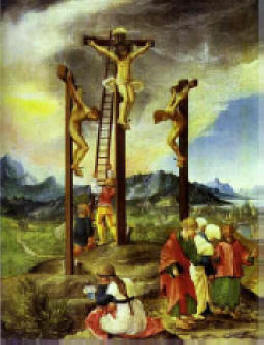

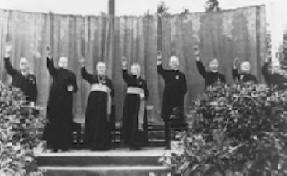
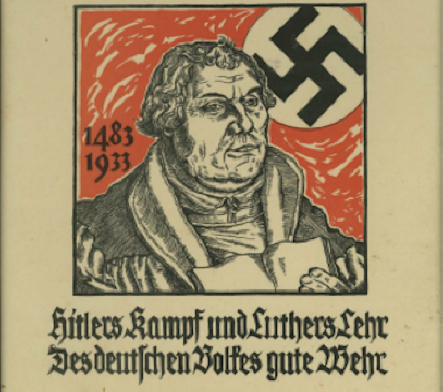
.jpg)
.jpg)
.jpg)


